
a collection of notes on areas of personal interest
- Introduction
- Arabic / Islamic design
- Arabic / Islamic geometry 01
- Arabic / Islamic geometry 02
- Arabic / Islamic geometry 03
- Arabic / Islamic geometry 04
- Islamic architecture
- Islamic urban design 01
- Islamic urban design 02
- Islamic urban design 03
- Islamic urban design 04
- Islamic urban design 05
- Arabic / Islamic gardens
- Gulf architecture 01
- Gulf architecture 02
- Gulf architecture 03
- Gulf architecture 04
- Gulf architecture 05
- Gulf architecture 06
- Gulf architecture 07
- Gulf architecture 08
- Infrastructure development
- The building industry
- Environmental control
- Perception
- The household on its lot
- A new approach – conceptual
- A new approach – principles
- A new approach – details
- Al Salata al jadida
- Public housing
- Expatriate housing study
- Apartment housing
- Pressures for change
- The State’s administration
- Society 01
- Society 02
- Society 03
- Society 04
- Society 05
- Society 06
- History of the peninsula
- Geography
- Planning 01
- Planning 02
- Population
- Traditional boats
- Boat types
- Old Qatar 01
- Old Qatar 02
- Security
- Protection
- Design brief
- Design elements
- Building regulations
- Glossary
- Glossary addendum
- References
- References addendum
- Links to other sites
Dress
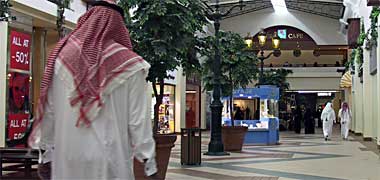
The clothes worn by Gulf Arabs are very familiar to those of us in the West. This seems true with respect to both men and women. We see their dress not only on television and in films, but also on our streets when they visit as tourists. Yet although it has an exotic look to us, this type of clothing has come about logically in response to the climatic conditions of the region. While the general understanding may be that men tend to wear white, there is considerably more variation than we might think.
Men
The dress of male Gulf Arabs is readily recognisable anywhere: a long white shirt topped off with a folded headscarf with a black rope round it. It sounds simple but this apparent simplicity disguises considerable variety which is one of the ways Qataris can demonstrate their individuality.
The thub is the basic dress and is very comfortable to wear as well as looking smart. It is worn relatively loose though many Qataris have theirs tailored to fit. While it is possible to buy them off the peg, all neighbourhoods have tailors working in small shops and providing their services to both nationals and expatriates.
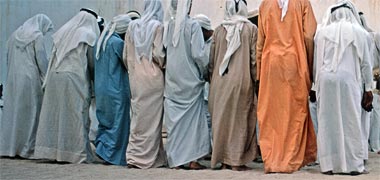
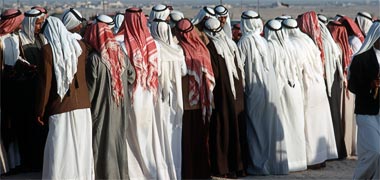
In summer the thub is nearly always white but in winter there are heavier weights with a variety of colours to be seen ranging from black through various shades of grey to browns and ochres. More dramatic colours are occasionally seen both in summer and winter, but these tend to be used by musical or dance troupes and are not common everyday wear. Whether white or coloured there are a wide range of materials used in their manufacture. The first photograph here was taken at a tambura in summer and shows a good cross-section of colours that would be worn not just by these Qataris dancing, but also out on the streets. The lower photograph, taken at a razeef, shows some of the dancers wearing white thiyaab with vests or jackets for warmth and some the heavier, coloured winter thiyaab.
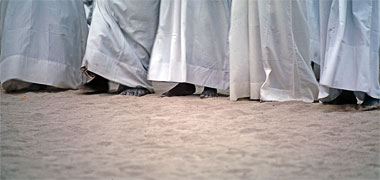
In order for the thub to hang well, the hem at the bottom is generally folded over at least once to create a little weight there. This photograph gives a good indication of the common finish to the garment, though it can be varied in depth. A similar treatment was traditionally used on the sleeves, although now many Qataris favour a Western style cuff worn tight to the wrist and either closed with a button or cuff-links, the latter very much a fashion accessory.
Qataris are very fastidious in the way they dress. Commonly a clean thub will be worn every day and there are some who will put on a clean thub after every prayer.
Mostly the thub is bought off the shelf but, with the large number of tailors in Doha, it is not expensive to have your thub tailor-made for you. This way you can customise the important elements of it to your own taste. This includes but is not limited to the:
- length of turn-up (which influences the way it hangs and moves),
- type of collar (standard – with its different lengths and cuts – banded or stand-up – I’ve never seen a button-down nor the collar-less as they wear them in the Oman and Emirates),
- cuffs (generally they are doubled for cuff-links),
- fly front or button-through,
- colour and arrangement of buttons, and the
- position and number of pockets (normally two side pockets and a single breast pocket on the left, but occasionally this is on the right).

I should add that there are a significant number of styles associated with stand-up collars, mainly to do with the number of buttons ranging from none to three and the size and quality of the buttons. Often the button holes are false or missing and the fastening is made with hidden press studs as is shown here on a collar which is fastened with two press studs.

But there are more expensive examples to be seen, usually on special occasions. Here, in a photograph taken in 1974, is a very expensive version which shows a tall, upstanding collar on a highly decorated shirt, the shirt being fastened with loops and pearls for buttons. The occasion on which this was worn was at a razeef, an occasion for which many will dress up in order to both honour the occasion as well as displaying themselves to good effect. Note how the end of the ghutrah has been tucked into the shirt to keep it under conrol.
Below the thub qataris tend to wear white t-shirts and the loose sirwal for comfort. It is noticeable that the badu appear to wear relatively heavy clothes in summer. I have been told that this is environmentally sound, the thub protecting the body from losing too much moisture quickly. In urban situations it is relatively easy to replenish the body’s water but, in the desert, it is not that easy so it is more important to inhibit moisture loss by limiting evaporation even if this means a little discomfort.
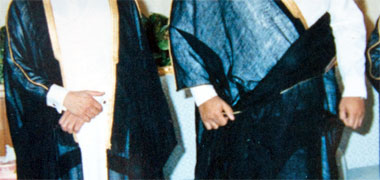
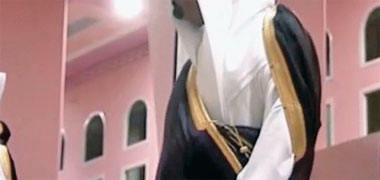
On formal occasions, Qataris wear a cloak known as a bisht over their thub. The bisht is a decorated cloak that is made from a light and transparent material in summer and from a variety of heavier materials in winter. The first two photographs to the right show the lightweight, black summer bisht and illustrate the characteristic manner in which it is worn. There is, as you might anticipate, a variety of ways in which they can be worn, but the bisht is generally hung loose over the shoulders, with the right arm tucked into the right sleeve of the bisht, and with the left shoulder sometimes outside the bisht or, more usually, with the bisht just draped over the left shoulder and with the left arm not enclosed by the left sleeve, or just supporting the left elbow. The photographs illustrate something of this variety of styles. This may seem like much ado about nothing, but the point is that individuals can be recognised at a distance by the manner in which they wear their bisht.

Finally, there are rules or at least habits which have developed for the wearing of the bisht with the iqal. In this photograph of the Ruler of Qatar greeting people on the occasion of the ’eid, it can be seen that the bisht always covers the iqal. In this case the habit obviously applies to Qatar but it might be different in other Gulf States as there are often stylistic characteristics which are used to show nationality or fashion as can be seen in the note below about the wearing of the ghutrah
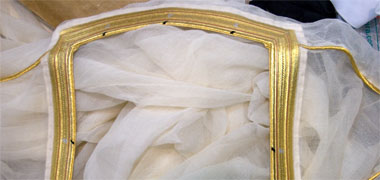
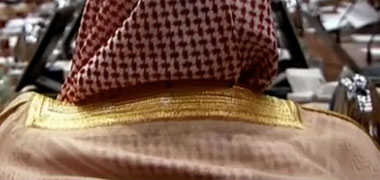
These next two photographs are of the fine lightweight, white and beige respectively, bisht of the type worn in summer, usually for formal occasions such as eid. The upper photograph shows the form of the collar with its square corners giving the collar a distinctive form. The lower photograph shows the collar to be a little wider than the upper one, suggesting a more expensive bisht. Note in both photographs how the piping which runs across the shoulders and down the arms sits roughly on the line of the inside of the back of the collar, allowing the weight of the collar to counterbalance to some extent the potential drag down the front of the bisht. Note also that the collar is nearly always displayed with the ghutra being worn tucked inside it, a style which requires a certain amount of looseness in the ghutra to allow for a certain degree of head movement.
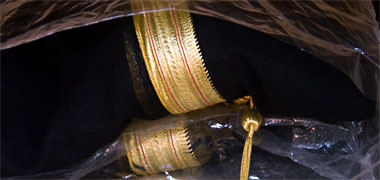
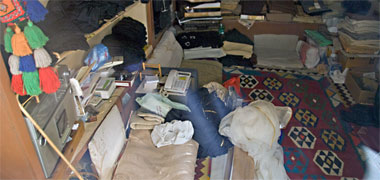
This photograph is of the heavier, formal winter bisht with similar decorative detail to its edges. Their fine weave and decorative detailing are the chief characteristics by which Qataris judge them and, by extension, each other. The work of Qatari tailors is fine as can be seen in these details illustrating the gold stitching. These examples were crafted by a Qatari tailor who has been working in a small shop in the suq all his life, as did his father before him. Although the workshops of the few tailors still working in Doha’s central suq are relatively small, the work is excellent. Customarily the tailors sit cross-legged on a small dowshek, here white, stitching furiously. Often they will use their feet to stretch or hold the material they work on. Sewing and ironing is all carried out on the floor. It is interesting to see that there are a telephone and radio within reach to keep in touch with the outside world. As in the rest of the suq, tea, coffee and water are brought from the adjoining shops for the tailor and guests.
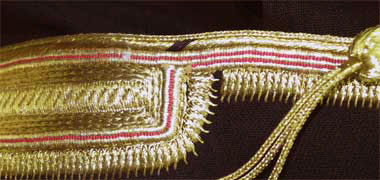

Generally the bisht will be woven from a black or brown material imported from Europe or the Far East. It is characterised by heavy gold decoration around the collar and lapels. The gold thread is usually hand-sewn and then beaten with a wooden mallet to fix the shape and produce the characteristic stiffness which helps keep its shape. Invariably there is a red thread used for contrast. The first of these two photographs show the junction of that part of the decoration which runs from the lower chest up and around the back of the neck on the left, with the general edge detail on the right. Part of a decorative tassel can also be seen. The lower photograph shows in more detail another pattern, this time fixed to the edge of a white bisht. These decorative edges are sewn in by hand and then beaten with a heavy piece of wood on a padded wooden anvil in order to shape and fix the decoration.
When the weather is really cold the badu wear a heavier, camel-hair bisht either by itself or one that is lined with sheep’s wool – though this often tends to be an artificial material nowadays. These cloaks usually have a simple embroidered pattern on them.

Directly on top of their heads Qataris wear a small circular skull cap known as a kufiyah. It is woven or made in a lace-like manner so has a number of small holes in it which helps it mould to and stay close to the head. On top of this is worn the ghutrah, a large square of light material, white in summer and a heavier, checkered pattern in winter. The checkered pattern is white and red or white and black though there are also white and blue, green or orange on the market. The red and white checks seem to be the favoured style with Qataris and, although it is commonly referred to as a ghutrah, its proper name is, perhaps, a shumagh, though this is the name that is commonly given to it in Saudi Arabia, Jordan and Iraq. I refer to it here as a ghutrah, as that is the name Qatari friends refer to it.

The square is folded on the diagonal and laid over the top of the head. It is kept in place both by the kufiyah below but also by the iqal on top. The latter is a black cord of about fifteen millimetres in diameter which is worn doubled round the top of the head. The kufiyah is also used as an element of style, being worn straight, tipped to one side or tipped forward or, more rarely, onto the back of the head.

Some uqul are worn as a plain doubled coil, but others have one or two tails hanging down. The number of tails and the pattern they make at the top with their junction with the thicker coil are fashion-sensitive. You can see in the accompanying photographs different ways of wearing the uqul as well as alternative types and styles of ghutrah. I’m also told that this is a way of distinguishing which part of the Gulf an individual comes from, but I don’t know what the rules are and suspect they change with time.

The standard ghutrah, if there is such a thing, is usually red and white or, sometimes, black and white. However, there are others seen from time to time, dark blue and white and green and white. Some Qataris will tell you that they would never be seen wearing colours other than red or black. There is a significant degree of difference in their materials and detailing, another of the elements that enable Qataris to distinguish themselves from others.
The design of the ghutrah, shown in the photograph above, is said to be a fat’ha or open design, the name being suggested by the open fish nets of southern Mesopotamia. But there are also suggestions that it is thought to be a honeycomb design – even though it is not hexagonally based – the reference to this coming from bee-keeping. The design of the edge of the ghutrah can be seen to be very different and is a version of what is known as qamah, being thought to be influenced by or based on the head of wheat.

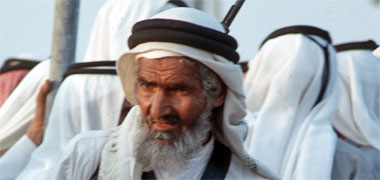
Just as the ghutrah has a wide range of types or styles, so does the iqal, the coiled and knotted rope that sits on top of the ghutrah and holds it in place, aided by the kufiyah worn immediately on top of the head. Always black, the kufiyah has differences both in the thickness of the coils as well as in the detail of the knotting at the back, the length of the hanging cords, and their detailing at the end. This photograph illustrates the detailing of a simple, inexpensive iqal. A further note on the iqal looks at its socio-cultural aspect.
The lower photograph, taken in 1973, shows one of the more traditional versions of the iqal being worn. Favoured by the badu it was commonly seen around the peninsula but was rapidly overtaken by the more modern, slimmer versions imported from a number of foreign sources. Originally it would have been made locally.

Here are four photographs of ghutrah to give an indication of the way they are worn in Qatar. The first four are the heavier ghutrah worn in winter, and all are worn with the ends lifted onto the top of the head both to give more ventilation around the sides of the head as well as for style. The bottom left ghutrah is of fine wool, plain but with a patterned band running round the edge. It is not that common.

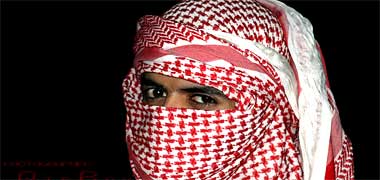
In cold weather the ghutrah can be wrapped around the front of the neck and face to give additional warmth as well as lending – as can be seen in this photo – an air of mystery. When the sand-laden shamal occurs, the ghutrah is pulled up over the nose to give even more protection to the face, particularly the nose and mouth. It can be tied tightly to provide not just protection to the nose and mouth, but also to ensure it stays on both in a high wind as well as when the wearer is engaged in an activity where its coming loose might be dangerous. It is a very flexible item of clothing being used both as a fashion accessory as well as having a range of functional uses. Everybody seems to have their own personal way of wearing them and this provides an easy way to recognise somebody at a distance. I should also add that, in the past, the ghutrah could be used to strain dirty well water, a function I’ve also seen used when camping.

These four photographs illustrate the lighter, white ghutrah worn in the hotter months of the year. When the weather is very hot the ghutrah is folded up on top of the head allowing air movement around the back of the head as well as being used for style statements – apparently easier than with the heavier ghutrah. You can see that the kufiyah becomes more important from a design point of view as it can be seen through the ghutrah in addition to being glimpsed when the ghutrah is folded back. In informal situations such as with friends in the majaalis the ghutrah is taken off though the kufiyah is often left on.

There are so many styles in which the ghutrah can be worn. Not only are there personal differences but there are also national ones. Qataris will be able to recognise friends at a distance by the way in which they wear their ghutrah, the style varying with the season, the temperature and the degree of formality required. The ghutrah is taken off for prayer and replaced afterwards, a time when it is useful to have a mirror in order to get the required effect. This photograph, taken in the suq shows a relatively complicated arrangement for holding the ghutrah on the top of the head.

The ghutrah can appear to be the most important element of Qatari or Gulf dress. It is common to see it being played with at all times, the front being crimped or straightened to a preferred pattern, and the sides lifted and folded in a manner personal to each wearer. You can identify people at quite a distance by the characteristic manner they wear their ghutrah.
![A popular way of wearing the ghutrah – with permission from [Qatari]™ on Flickr A popular way of wearing the ghutrah](./islamimages/ghutrahtent.jpg)
Here is another popular way of wearing the ghutrah. It keeps the cloth tucked away, gives additional warmth to the head in winter and also helps keep the iqal in place. It is, perhaps, a more functional way of wearing the ghutrah rather than a matter of style as many of the above photos illustrate. This ghutrah is made of wool and commonly has a coloured decorated border.

As you can see, there are many ways in which the ghutrah can be worn. Family, age, the time of year, the degree of formality – all these go towards establishing the way in which men will wear the ghutrah. Here, in the desert, three men sit on a sand dune and look over Khor al-udaid. By their clothes I would guess it to be autumn or winter. One is bare-headed while the other two each wear a different style of ghutrah, iqal and thub. They are relaxed, but it is noticeable that the ghutrah and iqal are still worn with style.

In really cold weather Qatari badu wear a heavy coat lined with sheep wool to keep the cold out, but Qataris can also be seen wearing some Western clothes as well as their traditional dress. I have seen jackets, heavy waistcoats and, as shown here in this photo of a badawi working in the desert, a heavy pullover. Note how he has wrapped his thick ghutrah around his head to help keep him warm.
In addition to this there is considerable use made of the ghutrah in fashion. It can be pinched at the front, thrown over the shoulder, worn with one side on top of the head or wrapped round the throat with many variations. These, combined with the rake of the iqal, produce a variety of styles that allow distinction and indicate pride in wearing the clothes.
Since writing the above notes I have been lucky to have been given permission to use the following set of photos to illustrate alternative styles with which men wear the ghutrah. In this case the styles relate to Saudi Arabia, though the styles are universal to at least the Gulf.
As I wrote above, there are many different ways in which the ghutrah can be worn. Here I am using the names given by the author of the original notes.

These two styles have been termed, on the left, the ‘Modesty’ and, on the right, the ‘Eagle’. You can see that the ‘Modesty’ is a casual way of wearing the ghutrah, perhaps more suited to colder weather as it drapes over both shoulders, close to the body. The style on the right is similar to it except that instead of letting the hanging end drape down, it is thrown back over the shoulder, trapping the other end of the ghutrah.

These two styles are the ‘Mr. X’ and the ‘VIP’. ‘Mr. X’ is definitely warm weather wear in that the ghutrah wraps closely to the body with both ends of it taken up and thrown over the opposite shoulder. This provides a relatively close framing around the face. The ‘VIP’ is so named as it is favoured on formal occasions such as weddings and receptions as well as by dignitaries, and mostly used indoors. Both ends of the ghutrah hang straight down, but a small amount of styling is favoured on each side of the mirzam. It has a significant formality to it, the sides of the hanging ghutrah creating a certain element of shielding to the face.

Here we have the ‘Teacher’ and the ‘Schoolboy’ styles. The ‘Teacher’ style has a formality to it due to its symmetry, but its usefulness to teachers is that with the ends of the ghutrah being thrown back over the shoulders, there is more freedom of movement allowed to the person wearing this style. Compared with that, the ‘Schoolboy’ style is thought to give a modern touch to a traditional style. With both ends of the ghutrah hanging down the back, one of the ends is brought under the other end and then over the shoulder to hang down the front of the body.

These two styles are the ‘Abu Rashed’ and the ‘Balance’ styles. The first is said to be named after the Saudi lawyer, Khalid Abu Rashed. One end of the ghutrah hangs straight down the back while the other end is thrown back over the top of the head. The distance it hangs down is said to be significant. The manner in which the other end of a ghutrah hangs in relation to the point of the shoulder is also significant. The ‘Balance’ style is also symmetrical from the front, with the two drops that hang in front of the ears being said to resemble the scale pans of a traditional pair of balances.

Here we have the ‘Cobra’ and ‘Butterfly’ styles. The ‘Cobra’ style was, apparently, popular in the 1990s, but was not an easy style to wear due to its geometry. It required more starch than usual in washing it, and the user had to remember to limit his movement in order not to destroy its shape. Note how much of the kufiyah is exposed. Compared with the ‘Cobra’ style, the ‘Butterfly’ is more informal, allowed greater movement and has a softer geometry to its shape.

This is the ‘Bin al-Bakkar’ style, though I can’t tell you why it is so named. Its styling is informal and suited to warmer weather as both ends of the ghutrah are brought up and on to the top of the head, and then are draped further away from the shoulders, one to the back of the body, the other to the front, leaving more space for the circulation of air. It is thought to be attractive and is relatively stable compared with some of the other styles.
Since writing the above notes I have come across another set of illustrations in the Dubai-based magazine Brownbook suggesting the characteristics of differing styles of men’s dress for six of the countries of the Gulf Cooperation Council. You should be aware that styles cross national boundaries, and that not every national will wear the styles illustrated for their country, but the drawings are clear and certainly give an accurate illustrations of the chief characteristics nationals in each country might display. Note that I have used the term, thub, rather than the kandura of the article. What follows is the text from the poster to which these two illustrations, created by Liz Ramos-Prado, are linked:
Qatari

Cobra: heavily starched and stiff to achieve its imposing look, inspired by the venomous snake. The material of a Qatari thub is often shiny and has a long and stiff tassle or shirt pocket.
Emirati
Teachers: Over the shoulders, easy to achieve – a common choice for teachers. Emirati thiyaab have no collar. They have a long loose tassle and matching embroidery on the sleeves.
Saudi
Bint al-Bakkar: Tough to master but a great look. Complimented here with a red and white checkered ghutrah. Saudi thiyaab are tight fit with two button collar with shirt sleeves made to have cufflinks.
Kuwaiti

Balance: Created by taking the ghutrah at symmetrical lengths on the shoulders and then throwing the ends over the head to create the shape of a scale when viewed from the front. Kuwaiti thiyaab, noted for their use of high quality material, feature a one button collar with a slim fit.
Omani
Mussar: A hat worn by Omani, unlike the ghutrah found in the rest of the GCC, embroidered with colourful patterns and personalised details. Omani thiyaab are collarless with short loose tassles attached just above the breast. Often colourful.
Bahraini
Butterfly: An easy, elegant and flexible look allowing for free movement of the neck, unlike some of the more complex, starched designs. Bahraini thiyaab are loose fitting with a soft shirt collar. They feature occasional details like shirt pockets.

Finally, here is a photograph of a drummer taken at a razeef in the 1970s. He is wearing something I have only seen twice, a white iqal. I have been told that a white iqal is only likely to be used for fun but, in this photograph it is obviously not the case, nor was it on the other occasion I saw it. I have not yet been able to sort this out but believe it may signify either death in the family, white being associated with death in this part of the world. Alternatively it might also signify blindness. On a different subject, note also the two-button collar, at that time a standard turn-down collar being the norm.
Shoes, jewellery and male adornment

There are two other areas of dress that should be added to the foregoing – shoes and jewellery which, for men the latter of which includes cuff links, pens, rings and watches. Here you can see a young man displaying his pen in his top pocket, cuff-links and a diamond-encrusted watch.
In the past Qataris would have worn sandals or gone bare foot. Sandals were originally made out of material that was to hand, particularly of leather. There is a traditional Arabic leather shoe or sock that looks like a soft boot without a protecting sole, known as a khuff, but I have never seen them other than in advertisements and don’t know how they are worn other than, I assume, with shoes or sandals.
![A pair of black sandals – with the permission of » Zitona « [09] on Flickr A pair of black sandals](./islamimages/blacksandals.jpg)
Sandals are worn by all as they are comfortable in hot weather. They are also worn in winter and can be seen with socks, themselves subject to fashion, and ranging from fine silk to heavy wool, nearly always black or grey. This pair of black sandals are the type of footwear generally worn by Qataris nowadays. They can be thought of as the modern sandal compared with the more traditional one shown below. Sandals are comfortable and easily taken off as is customary at the masjid when feet will be washed, or for comfort when entering the manzil or majaalis. Modern sandals come in a range of colours, brown and white being particularly popular.
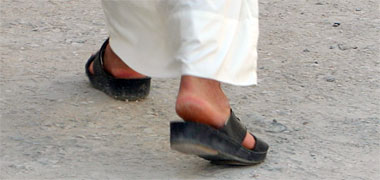
Here you can see an ordinary pair of sandals being worn by a Qatari in the suq. Fabricated of leather or plastic they are relatively substantial and usually have a good sole and heel to them if they are to last any time. These would not really be considered a fashion item but are more functional as they may be used over a wider variety of surfaces during the day than might be the case in the West. Although I have no photograph of them, you can also see Western shoes worn with the back pressed down by the heel to resemble sandals.
Traditional sandals have two straps at the front, one for the big toe, the larger for the other toes, the straps being relatively large and covering much of the foot from sight. The better quality ones tend to have less height to them. Incidentally, sandals are often known as juwti, although this is a Punjabi word.
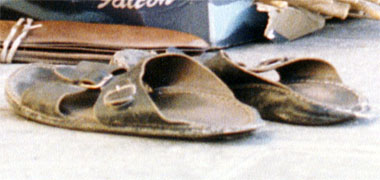

Here are a very typical pair of worn sandals that have been taken off while their owner sits with a friend in the street. We all like comfortable shoes that have settled in to the shape of our feet. Although most people like to be seen in new clothes, and looking good, there are still a lot of men who prefer shoes they are familiar with and which, in the desert particularly, will not be ruined by the environment in which they protect the feet.
This detail of a photograph shows a pair of sandals being adjusted in the suq. As in other countries, a large part of the retail market is brought in from abroad. Shoes tend to come from Europe at the high end of the market and from China at the lower end. Even though this photograph was taken in 1985, some items such as sandals are still made or assembled in Qatar as I saw in 2008. Here you can see a thick wooden sole having its straps screwed on.
Shoes are important in the look of the dress. They are rarely lace-up but are slip-on or zipped. I can’t say that this might be because of the lack of familiarity with laces, but I think the need to take shoes off far more than we do in the West has something to do with it. Shoes are removed for prayers and left at the door of musajid. They are also left at the door of friends’s majaalis which are invariably heavily carpetted. It helps to be able to slip them off and on with ease.
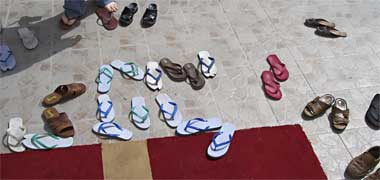
An inexpensive form of sandal, the plastic flip-flop, is commonly worn by most of the workforce, but not usually by Qataris, even at the sea-side where leather continues to be worn. It is ubiquitous and is a common sight outside musajid at prayer time. In this photo I see that one pair has even been customised to differentiate the big toe from the other four toes. I wonder if this is a new style…

Compare the flip-flops above with this sandal. Worn by a Saudi man, it is expensive and heavily styled. This form of sandal is very similar to those commonly seen throughout the Gulf, worn by well-off men, and will be one of a number of similar styles they will have in their wardrobe. In winter sandals are not usually worn by urban men when they are more likely to wear a Western shoe and socks, but it is not uncommon to see sandals continuing to be worn, but with heavy socks for some or fine silk socks.
A final note on sandals relates to their use as weapons or threats. Occasionally you might see an argument or mock argument when men or, more likely, boys will take off their sandals and threaten others. While the sandal and the iqal might be used in this manner, the sandals have the added advantage of adding insult to injury as there is an Arabic curse suggesting that somebody is lower than the soles of his sandals.
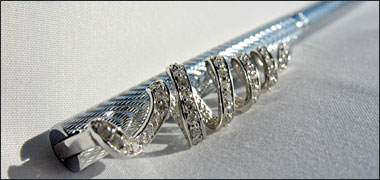
My impression is that footwear is as important in look as the jewellery, but the emphasis tends to be on the latter, particularly watches. Most Qataris will own a number of pairs of cuff-links, rings, pens and watches. Some have drawers full of them as they are both fashion items and objects commonly given as presents. Here is a photograph of a heavily decorated pen, for instance. Watches tend to be worn loose, low on the wrist and are, I think the main object of desire. Many have rings with a diamond displayed but there is a tendency also to demonstrate something of their past by having American College rings for those educated in the States.

I should add a final note on this subject though it might not, at first sight, seem to be appropriate in this category. It is common for men to carry in their pockets – and often to be seen fingering – misbah, or prayer beads, sometimes irritatingly known in the West as ‘worry beads’. The misbah consist of a looped ring of either thirty-three or ninety-nine beads with a heavier bead at the termination of the loop. I have seen sixty-six beads on a ring but believe this to be unusual. There is often a smaller bead included to mark off every eleven beads. The purpose of the beads is to assist in reciting exhortations to God in cycles of thirty-three.
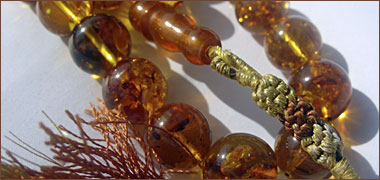
But the reason misbah are noted here is that they tend to be a common form of jewellery. Although there are inexpensive ones as shown in the above photograph, usually of plastic or wood, there are some beautiful versions in rare or precious materials such as amber and pearls, some of which are extremely expensive. Well-off Qataris will have a number of good quality misbah and they can be seen to be a fashion item while fulfilling an important religious role.

The khanjar is not a standard feature of Qatari dress as it is in some parts of the Arabian peninsula, and will not normally be seen worn on the streets. However, I have seen them worn at razeefs as shown in this first photograph, and I know that it is also worn in the Emirates at similar events. Its use is noted here as some in the West believe that everybody wears them as a part of their national dress. Certainly they are associated with past traditions, particularly of the badu and, in this they reflect the cultural associations of bravery and honour. But with settlement, many habits change.

The second photograph of a khanjar is used here in order to show a distinct difference between Gulf dress and that of Oman, a state on the south end of the Arabian peninsula, and where the thub, shown above, is also very different from those worn in the Gulf. There are other features of Omani dress which distinguish them from the Gulf, but the wearing of the khanjar is considered de rigeur by many of the residents of the south part of the peninsula and can be seen on the streets there as well as occasionally in the United Arab Emirates which shares a border with Oman.
Although I added ‘adornment’ to the notes on women, I did not do so for men. But, thinking about it later, I thought I should add a note on them too. Men in the West are considered to be more vain than they used to be, and one way in which this is demonstrated is in the range and extent to which skin and other treatments are being formulated and bought. This is true too for the Gulf.
There has always been a pride in appearance but, where there is so much advertising and branding it is not surprising that men buy and use visual and olfactory aids. Thus it is common to note two groups of products used: perfumes and dyes. The first is mainly in the form of after-shave products but it is not unknown for perfumes to be used as well by men. The second product is a different matter.
There is an imperative in badu society for men to maintain their appearance and their youth. Traditionally men will want to show their vigour as long as they can; one way this is effected is in procreation though this is also a political activity, an issue which I have discussed elsewhere. With regard to adornment the noticeable effect of this trend is for men to be seen to dye their hair, beards and mustaches and, additionally, for them to wear kohl around their eyes. As you might expect, the use of dyeing is not common in the young, but I have seen kohl used on both young and old, but particularly the latter.
Women’s dress
The way in which Muslim women cover themselves when outside the house is the result of a combination of disparate factors. These apply to Qatari women as well as those elsewhere in the Islamic world, though the resulting dresses differ in a number of ways. This is an area for division and concern and one that should not be underestimated in its impact on day-to-day living for Muslim women. Women’s dress in the Islamic world is now an extremely complex cultural and socio-political issue.
At its simplest, Muslim women are bound by dress requirements set out in the Holy Quran and expanded by a number of hadith which establish standards of coverage for their bodies. These are generally accepted as covering the whole body apart from the hands, feet and face while in the presence of anyone other than those to whom they are related or married. This coverage includes the chest and neck. While this may seem relatively simple and result in a code that would be understood and used world-wide, arguments are being made by Muslim scholars which, while debated around religious issues, also draw in and relate to cultural and political differences. For instance, some Muslim women allow themselves to be seen outside the house with their hair uncovered and with relatively low neck lines while, conversely, a Saudi woman requested a divorce because her husband tried to see her face while she was asleep by moving her niqaab, admittedly this was based on a tradition pre-dating Islam. It should also be noted that the practice of women covering their faces also pre-dates Islam and is likely to be of Zoroastrian Persian, and Christian Byzantine origin.
Muslim women’s dress varies considerably from country to country, the differences generally being ascribable to cultural, educational and political factors. While this may be thought to provide a code or direction for each geographical area, it has introduced divisions within them depending upon interpretations of these factors, together with other issues such as those related to human rights, feminism and the influence of other cultures – particularly when Muslims live in countries where the constitutions are not based on Islam.
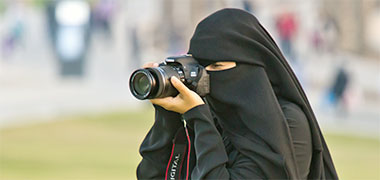
One of the results of this has been the curious position where, in some areas, women are taking to wearing the hijab or niqaab because they feel partly or wholly pressured to do so. These women are understood to feel oppressed by what they see as male dominance, a socio-political issue which is seen in movements in many countries towards equality, or a degree of it, and the hijab or niqaab are perceived as symbols of what women see as oppression. Yet other women are embracing cover as they feel empowered in doing so. Two differing rationales I have heard is that the anonymity brought by overall coverage gives women a strength which has much to do with men not being able to judge them; and that embracing the hijab or niqaab demonstrates the depth of their religious conviction. Here a young Qatari woman, her face hidden, enjoys the freedom to take photographs in a public park in Doha.
In the Gulf there are considerable differences in the way in which women dress, both in terms of the type of clothes worn as well as their design and the amount of exposure of the body. These differences are even more pronounced when added to the styles seen outside the Gulf. Also bear in mind that, in some countries such as the north African states and Turkey, some women wear Western dress, though this might be customised with a slight Islamic influence; for instance, jeans and tight top worn with a headscarf. This may give the impression that the choice of dress is elective. This is not always the case as in, for instance, France and Turkey, where Muslim women may not necessarily wear what they wish. In Qatar, times are changing and elements of this change can be seen both within and outside the country.


These first two photographs are of two of the daughters of Sheikh Hamad and Sheikha Mozah. The daughters are important in two ways for the purpose of these notes: firstly, they are a very visible example of the manner in which women are being made more visible in both a practical and literal sense and, secondly, this is how many modern Qatari women appear. Sheikh Hamad and his wife, Sheikha Mozah, are intent on educating Qataris, and particular emphasis is being placed on the education of women. Two of their daughters, Sheikha Mayassa and Sheikha Hind are seen here in, respectively, the Museum of Islamic Art and Diwan al Amiri, both in their official capacities as respectively, President of the Qatar Museums Authority and an advisor to Sheikh Hamad. The faces of the two Sheikhas are uncovered and they might be considered to represent an official look for modern women in a Gulf State. They are role models for young women in Qatar.


Bearing in mind the traditions of Qatar and the Arabian hinterland, it is interesting to see that not only are young women increasingly showing their faces in public in Qatar, but they are doing so in an official capacity. These next two examples illustrate how Sheikh Hamad’s family may be seen abroad. The first photograph is, again, of Sheikha Hind, this time at a conference in Damascus, Syria. Unusually for a Gulf Arab she is wearing no headdress at all and in many ways appears no differently from a Westerner. In the second photograph, Sheikh Hamad’s wife, Sheikha Mozah, is seen at a parade for Bastille Day in Paris dressed cleverly in a fashionable style and wearing a toque hat which goes far in covering her hair while appearing modern. With the exposure she, particularly, has in public both at home and abroad, a very strong message is being transmitted about the way she and her husband see women progressing.
Having said that, when Qatari women will be seen in public, their outer garments will nearly always be black. The abaya is the standard outer garment they wear and although it appears to Westerners as a simple garment it is, like many clothes, subject to fashion. In an increasingly consumer driven society there is a balance to be made between sustaining some degree of fashionability and its attendant attraction, and maintaining privacy and the good name of the family. Most men appreciate the fact that the abaya is there to protect women from being seen and are particularly concerned that their wives and women in their family should wear it. Some believe that the beauty of their wives should be seen only by themselves, some see it as the proper reflection of the Holy Quran’s injunction that women should be modest and completely covered – 24.31:
And tell the believing women to lower their gaze and be modest, and to display of their adornment only that which is apparent, and to draw their veils over their bosoms, and not to reveal their adornment save to their own husbands or fathers or husbands’ fathers, or their sons or their husbands’ sons, or their brothers or their brothers’ sons or sisters’ sons, or their women, or their slaves, or male attendants who lack vigour, or children who know naught of women’s nakedness. And let them not stamp their feet so as to reveal what they hide of their adornment. And turn unto Allah together, O believers, in order that ye may succeed.
This injunction is seen to apply only to relatively young women as the Holy Quran also states – 24.60:
Such elderly women as are past the prospect of marriage, there is no blame on them if they lay aside their (outer) garments, provided they make not a wanton display of their beauty: but it is best for them to be modest: and Allah is One Who sees and knows all things.
It is generally considered proper that women’s form should not be seen and, consequently, that garments worn in public should be loose enough to disguise their form. However, there are forms of the abaya that are more close-fitting – such as the ‘Paris’ style though there are other, looser fitting styles that come in and out of fashion such as the ‘farasha’ (butterfly) and ‘fish’ styles. More than this there is an increase in the variety of materials used in their construction as well as a significant amount of decoration that can be found on them. Generally, the latter abaya is likely to be worn only on special occasions or visits and is not the style that would be worn in public.
Some Gulf Arabs, particularly the young, as in the West tend to push the boundaries of what is acceptable. It is not uncommon to see them in small groups in the larger retail centres wearing their abaya loosely so that the clothes they wear under them – which are very similar to those that would be worn in the West – can be plainly seen. In addition to this there is a considerable range of transparency in the materials from which the abaya is made.
There is also an increasing amount of colour being used for the design of abayaat. In the main this is to be found on Muslim women in the Western world who wish to show their independence by expressing themselves through style and, perversely, in order to demonstrate their religious identity. The strong use of colour is also a characteristic in other Gulf states, particularly the United Arab Emirates where it is also a function of high levels of disposable income. In contrast to this, many Muslim women will only wear black as mentioned above, or a very dark tone in order not to stand out and have people look at them.

Deviation from complete coverage, the wearing of black, varying degrees of clothing transparency and applied decoration are likely to be due to the natural interest of youth in what is happening around them, though this has much to do with the influence of the West and the desire to be fashionable. This goal is considered by religious authorities as un-Islamic. But despite this, the considerable wealth of the Gulf countries has attracted the main Western fashion houses and their associated providers of accessories – jewellery, shoes and handbags being extremely important fashion items. In this photograph, trim has been applied to the cuff and sleeve of the right arm of the abaya. Here the trim is red but more commonly it is likely to be silver, sometimes with added sequins. Considerable sums are spent on clothes and accessories, in general the fashions being seen only by other women in the parties they hold while their men enjoy each others company in their majaalis.
There have been two particular trends discernible by the interest of Western fashion houses and the increase in wealth. The first is the manner in which these designers have adapted their dresses to accommodate local requirements. This has resulted in dresses being lengthened and more material added to the top to mask the chest; there has also been a lengthening of sleeves – all this in deference to the requirements of the Holy Quran. The other notable area of change is the dramatic increase in the purchase of designer underwear.
It should be noted that the interest of Western fashion houses is not new. In the past, merchants or their agents would move from house to house displaying and selling their wares to those with the funds to buy them. The difference is that, nowadays, many of the women who would remain in their houses now venture out in order to participate in the exhibition which shopping has become.
One other factor which should be noted is that the covering of the head is not always carried out with a scarf or veil. In some parts of the Arab world turbans, snoods, toques, bonnets or caps are worn as alternative styles to head cover though they only cover the hair or part of the hair, and they leave not only the face uncovered, but also the neck. Many of these items are extremely fashionable and can be seen in public, particularly on formal occasions, but they can also be utilitarian and are often seen within the house as they keep long hair in place while household chores are being carried out.
The Qatari or Gulf-style abaya is worn loose and covers the body from shoulders to feet. To complete the outer dress, the most common form of head covering is the hijab which is the garment worn by the majority of Qatari women. However, this takes a number of forms both in Qatar as well as other Gulf states though there are definite forms which can be distinguished. But it is the batula which best distinguishes Qatar and the Gulf states, though it increasingly appears to be worn only by older women.
Having said that there is often confusion in Western minds as to the type of covering worn by Muslim women and it should be borne in mind that some styles are characteristic of areas other than the Gulf though, of course, some women seen in the Gulf come from other areas of the Islamic world and bring their regional styles with them. Here is an attempt to distinguish between them. Bear in mind that all these items are usually black and that there is significant variation in the styling and method of wearing each type, new designs being increasingly introduced.
The niqaab
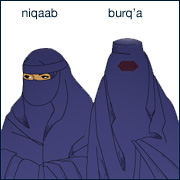
Similar in respect of its coverage of the face to the batula – particularly the longer model commonly worn by badu women in the desert – the niqaab is worn with a head-covering scarf such as the hijab, and covers all the face except the eyes, though sometimes a light veil is also worn to give additional cover to the face. Much of the debate in the West about the degree of coverage of the face revolves around the wearing of the niqaab.
The burq’a
The most extreme form of covering for women is the burq’a which comprises a complete cover for the body, including the face, and sits on a cap which can take different shapes below it. Often this cap takes the form of a pill box as is illustrated here. Vision is highly restricted and is obtained through a loosely woven lattice mesh. It is a common form of dress in Afghanistan and some parts of Pakistan.
The khimaar

Reaching to about waist level, the khimaar is a cape-like covering worn over the head. Fastened below the chin with a pin, it leaves the face open, covering the hair, neck and shoulders. A degree of individuality is obtained by the pattern and degree of folding required above the temples in order to take the material around the shape of the head.
The chadur
The chadur is typical of outer wear for women in Iran and may also be seen in some parts of Iraq. It is a full length cloak reaching from the top of the head to the feet, fastened under the chin with a pin, and is sometimes worn with a small scarf underneath, over the head and seen between the hair and chadur. The extent to which the hair and face is displayed is subject to religious and political policy, and may be policed as are women’s clothes in a number of Islamic states.
The jilaabah
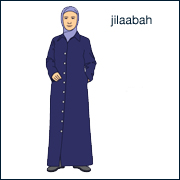
The general name given to a long, loose fitting coat is the jilaabah which covers most of the body from the neck to the feet. jilbaab are usually worn outside the house, but in many respects they are similar to housecoats. Although I have said it is loose fitting, it may be styled and worn closer to the body. The jilaabah usually has two hidden pockets at the sides incorporated into its seam. It is fastened at the front with either a zip or buttons which may be exposed or concealed.
There is some discussion as to whether this is likely to be the same garment referred to in the Holy Quran, and usually translated into English as ‘outer garments’ – 33.59:
O Prophet! Tell thy wives and daughters, and the believing women, that they should cast their jalabeebeeheen over their persons (when abroad): that is most convenient, that they should be known (as such) and not molested. And Allah is Oft-Forgiving, Most Merciful.
The amira
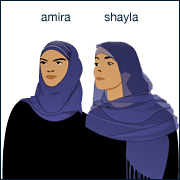
The amira is a covering comprised of two pieces and may be seen as a form of hijab. An underscarf is fitted closely to the head and then a tube of material is pulled over the head leaving the face and a little of the underscarf exposed, but covering the neck. The amira does not reach as far as the shoulders.
The shayla
Made from a solid or slightly transparent material, the shayla is a square scarf, worn over the head and loosely wrapped around the head, neck and shoulders, and fixed in place by tucking or pinning to the abaya. It permits considerable flexibility in use and allows more air to circulate around the head and neck. Generally it is worn over a cap or band to cover the hair, though personal style will allow hair to be seen.
The hijab

One of the most common form of head covering in Qatar, the hijab is a square scarf folded and worn over the head and around the neck, leaving the face, but not the neck, exposed. Its styling is created through the material colours and patterns used in its selection, the manner in which it is arranged tightly or loosely around the head, and the extent to which it covers or reveals the neck and forehead. It may be embroidered or otherwise enlivened with a variety of inexpensive or expensive materials and, in some parts of the Arab world there may be pendant items attached to its edges. When worn loose, the The hijab and shayla may allow the ears and associated jewellery to be exposed. The name, incidentally, is derived from the root hajaba, meaning to hide or cover.
The batula

In addition to the wearing of the abaya and shayla or hijab, many Qatari women wear the batula. I have been told that it is traditionally worn by married women, but I know it is also worn by young women who either want to remain unmarried or who believe they may never marry. As such it represents a symbol in progress through the stages of life as well as a mark of traditional respectability and family status. The decision to wear it can be personal or induced through decisions in the family. Those which are used in Qatar tend to be more restrictive by being fuller and having smaller eye holes.

There appear to be two forms of batula, that traditionally worn by badawi and that by more urban women, though you should be aware that this is really a distinction I have made as I have seen exceptions to it for both styles, and each differs in any case. The example to the side, and those above, are relatively full ones and have small holes for the eyes, indicating that they are designed to give almost complete privacy to its wearer. Note the unequal length loops used to tie it round the head. Compare this batula with the three, worn, examples below.
The batula i associated with the badawi is similar to the niqaab, and comprises a satin band across the forehead from which hangs a two-layered cloth, one the length of the face the other reaching the upper chest. The niqaab has a longer second layer which is thrown back over the head leaving the single layer at the front hanging round and below the eyes. It may also have three layers.

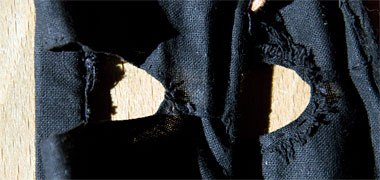
The upper of this pair of photographs illustrates two different batula, the photograph showing them from their inner side. They are both of a very ordinary quality and would have been worn by women with little wealth; this is particularly true of the one on the left which has been constructed from a single layer of coarse black cotton with the bottom untrimmed. I believe it likely that this was used by somebody in or from the desert as it emphasises function over form, suggesting that its appearance was not that important to the owner. The batula on the right is a more urban form.
The lower photograph shows the larger batula folded in order that, on the left side of the photograph, the outside can be seen along with its enf or nose piece and, on the right, the crude character of the stitching around the eye hole is evident.
This crudeness is also true for the batula on the right, above, although it is turned and finished on the sides. In both cases the nose piece is a strip of wood inserted into a vertical fold in the fabric. Both batula have relatively small openings for the eyes, but note the good quality woven cord for the batula on the right.
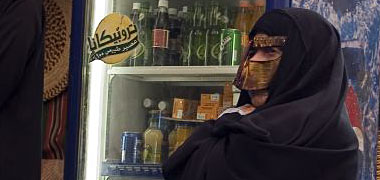
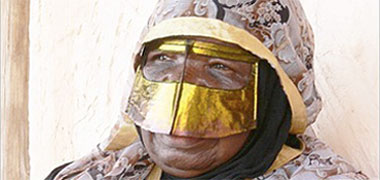
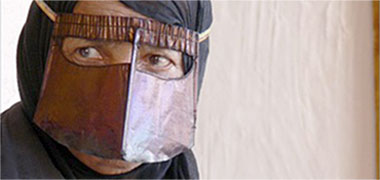
The batula is not a loose cloth; it is made from a stiffer material, covering only part of the face and leaving the jaw and neck exposed. These three examples are relatively long, particularly the first and third and, as have all of them, there is a structural element that runs down the line of the nose. This can be up to a centimetre in depth. That being worn below it can be seen to be sculpted to give more exposure to the jaw and chin. The eye holes are of different sizes and shapes depending on fashion and whereabouts in the Gulf the wearer has come from. My experience is that the Qatari form hides more compared with other Gulf states such as Bahrein and the United Arab Emirates. The middle of these three photographs looks to me similar to those worn in the United Arab Emirates and, compared with the others, is more highly coloured and decorated, the lower two bataateel having a narrower nose piece. Note, too, that their lower edge is curved whereas the Qatari ones above have a straight lower edge. There is obviously greater privacy afforded by a batula with a straight lower edge as it conceals more of the neck and jaw, but it is interesting to see how the lower, curved edge presents a more accurate reflection of the jaw line as well as appearing to be a more attractive solution to privacy because of this.

For a comparison with the above, here are a group of four Omani bataateel, photographed at an exhibition in the British Museum, London. The two on the right are relatively small but with small symmetrically curved eyeholes let into them, while the two on the left are more intricate having an external rectangular shape with the top left being intricately decorated and the bottom left batula fashioned from a heavy material and having a large, squared opening for the eyes with the dividing enf created by a small stick.
One particular characteristic of the batula worn in Qatar is their colour. The urban batula, if I can distinguish it from the cloth variety by calling it that, appears to be covered with indigo which comes off on the face, and they have a golden sheen to them in sunlight as is clearly illustrated in the centre photograph. I don’t know how they are constructed, though the material appears to have a canvas-like quality, nor how they finished though I do know that the nose piece is stiffened with a flat piece of wood. Some of them can be very decorative, particularly with regard to the band and cord which hold the batula in place.
One disadvantage of using indigo dye to colour the batula is that it tends to rub off on the face, a problem which can be seen both under the batula as well, of course, when they are taken off.
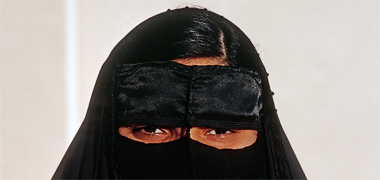

These two photographs have been included in order to illustrate the different effect created by wearing two common styles of face covering. Here the same young woman is shown wearing the typical mask seen on badu women in the first photograph and, in the second, the more urban batula. Of course there is no rule to who wears what, and where and I have seen the batula worn in the desert and the mask worn by young Qatari women.
The batula is worn all the time and, as far as I am aware, is only taken off for sleeping though might be worn in bed when sitting up. In this respect it seems to be the most important element of female privacy, which makes the increasing exposure of the face and hair in public a notable and significant cultural phenomenon.
However, this habit may be on the wane as some women will discard it on entering the private part of their home when only family and, perhaps, female friends will see them. Notice that, on the lowest of the three photographs above, the batula has been worn above the shayla, illustrating that it has been put on last.
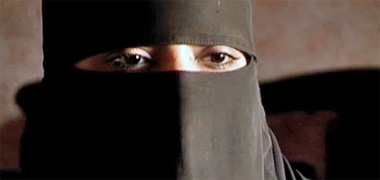
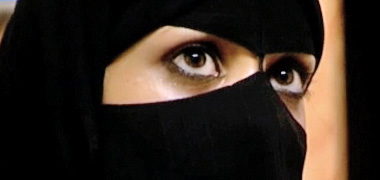
Here are two more photographs that I am including for a specific purpose. Both of them are of young Saudi women and illustrate, in the first place, the difference that might be effected from two similar types of batula. There are two obvious differences in that the top batula has a far narrower opening for the eyes while the lower batula has a thread to hold the centre of the opening while the sides have been allowed to expose far more of the face. They illustrate the different degrees of privacy required by their wearers, a reflection of their observance of propriety or of Islam.
The second point to make is that the young woman in the upper photograph is wearing no make-up, while the young woman below is wearing kohl, a common application to the eyes of women and, in some cases, men. The combination of strong eye-lining and the focus created through the opening of the batula produces an extremely alluring effect.
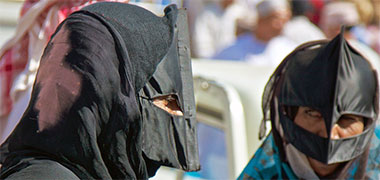
As can be seen illustrated in the photographs above, there is variety to the form of the batula both in terms of its materials and shape. The bataateel can be seen in different forms within the Gulf but, in that part of the Arabian Peninsula facing the Arabian Sea, Oman, the batula can take a much more conservative form, one which creates far greater masking to the faces of those women who wear it. However, within each society there is variation and here it can be seen that these two older women are wearing bataateel of slightly different styles. That on the right permits a larger part of the face to be viewed than that on the left as the spaces for the eyes are larger, and that part of the batula masking the lower jaw is not as deep as that on the left. These bataateel are dramatic in their design, this being to a large extent a result of the long ’enf which runs from below the lower lip to a point level with the top of the head.
more to be written…
Qatari women’s dress
As is mentioned above, women tend to wear a variety of dress below their abaya. The main difference between Qatar and the West is that the majority of clothing covers the legs. Jeans and trousers for the young as well as a range of house dresses, caftans, suits and sirwal qamees and separates are the normal wear around the house and in private.
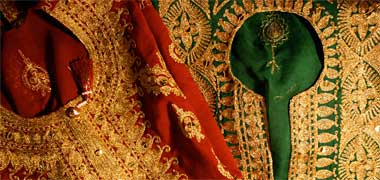
Traditionally Qatari women wore and, in the main, still wear long dresses not only outside the house but also inside. There are exceptions, of course, but modesty is an imperative for women’s clothing. This first photograph illustrates two traditional dresses worn by Qatari women. The colours are always strong with red and green appearing to be very popular, and there are significant amounts of gold embroidery worked in panels, particularly across the front of the dress which reaches to the floor. That on the left has small gold buttons, the other is worn open.

In this lower photograph, two young girls are wearing traditional dress which is usually a strongly coloured and patterned material in the form of a full-length fustaan or dress with long sleeves and includes a decorated head dress worn pinned under the chin to provide a modicum of propriety, covering most if not all of the hair. By this age, most young girls will not be out in the public arena but will be confined to their house and its immediate curtilage unless accompanied by older members of the family. Sometimes this will be their father or older brother but, more usually, the women of the family who would be taking them to visit other members of the family or female friends.
more to be written…
Accessories, shoes, handbags and jewellery

Anybody moving around the retail shops in Doha will have seen something of the jewellery that is on display. It is not just that there is a lot of it, the items generally tend to be generous in size, a fact reflected in their value. Women buy and wear a variety of accessories as they increasingly follow fashion. Shoes, handbags and jewellery are significant areas for purchase by women. As mentioned earlier, designers of clothes, shoes and jewellery have been established in Qatar for some time and their products readily purchased. For the really up-market items, and where privacy or security is an issue, agents will visit houses to show and sell their products to their clients.

But usually the place for ordinary Qataris to purchase their gold is in the gold suq, a specific area of the suq specialising in this commodity. Here you see a typical row of bracelets displayed for sale. More recently, however, a number of international design houses have opened outlets in the new retail developments which have sprung up, and these are significant attractions, both for shopping as well as window-shopping. Nevertheless, agents still visit houses with their more up-market products, and there are many Qatari women who would never buy in a shop unless, perhaps, they were abroad.

Accessories are essential as a means of demonstrating adherence, or not, to fashion with women in some parts of the Arab world being very much driven by a need or desire to follow the latest fashions, just as they might in the West. This has been particularly true of Dubai and, to a lesser extent, the other Gulf states where the amount of disposable income fuelling this activity is also significant. What is noticeable on women is that the relatively plain outer clothes cover often extremely expensive clothes, sometimes permitting glimpses of those clothes beneath them, exaggerating their appearance by contrast. Shoes are the most obvious hint as to what a woman might be wearing as they are not readily covered.

The most important difference with regard to shoes is that men’s fashions are not so marked as they are for women – though I would perhaps make an exception for trainers. Women’s shoes tend to follow fashion closely. While this may reflect international trends, Gulf fashions do not always follow them but tend to reflect more extreme styles, while following the more famous shoe manufacturers. As there is with the design and wearing of the thub, there are small but extremely important variations in dress for men. For women differences are more extreme. With regard to jewellery there really is a difference as women may purchase expensive pieces, and there is also a tendency to buy sets of jewellery. Hence it is not unusual to see a matching set of watch, earrings, necklace, rings and bracelets – significantly more expensive than a man’s watch.
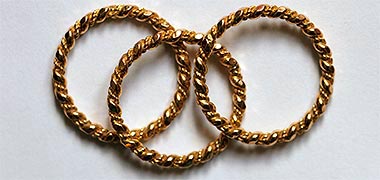
Previously I have mentioned that there is a tradition for women to buy or have bought for them, gold, both as a security as well as an adornment. This is usually in the form of jewellery and is normally worn in the form of bracelets, iswarah, or bangles, muthaad on the wrists. Sometimes there are matching rings to be worn with them, as in this first photograph, but for obvious reasons, bangles have greater value and might be thought to be preferred for that fact alone.
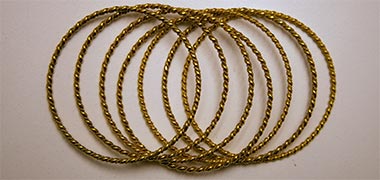
Gold bangles are very common presents for young girls. Bracelets and bangles are commonly heard as much as seen as they tend to be worn in multiple arrangements on the wrist. I understand that there should be a maximum of seven on each wrist, but can’t recall who told me, nor the reason for this number, though odd numbers are often favoured for their asymmetry. Perhaps bracelets might be worn in pairs on each wrist, so that there may be two, four or six though I have seen considerably more of the finer bangles worn as well as a mixture of different styles of bangles worn together.
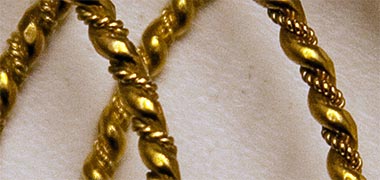
Gold in Qatar is generally of 21kt, though 22kt is commonly brought from the Indian sub-continent, both of them qualities which are higher than the standard 18kt and 14kt used in the West. Incidentally, the word ‘carat’ or ‘karat’ is derived from the Arabic qiyraat. The bangles shown here were made to order, as is the custom, in the suq and are of traditional design. Though simple, you can see in the lower photograph, the richness created by the detailing.

As can be seen from the photograph above, the bracelets are simple in design but here you can see a more detailed bracelet – known as kaff – which is a combination of a bracelet attached from the wrist to finger rings. I have seen them worn as normal jewellery by well-to-do Qataris, but understand that they are more usually worn at special occasions, particularly at weddings.

This photograph was taken from an old Ministry of Information poster that was also issued as a postcard. It illustrates a decorated gold necklace. The form of the necklace seems designed to maximise the amount of gold on display, the plates forming the setting for a number of semi-precious stones set in a relatively regular and symmetrical pattern though, as you will see, they are not completely mirrored in their placement.
I should mention in passing that some clothes are extremely expensive, both from fashion houses as well as can be traditional dresses locally made. I have seen traditional dresses covered in Gulf pearls that are worth thousands of pounds. Not every dress is in this league, but there is certainly a lot of money spent on clothes for women. Dressmakers were always available to produce made-to-measure clothes, but this has been taken further by the haute couture houses who dress many clients in Qatar.

It is not only adults who wear jewellery, for young girls also can be seen on high days and holidays wearing, in the main, gold jewellery. Issued by the Ministry of Information’s Tourist Department, the poster from which this photograph was taken illustrates a good example of the character of this traditional type of jewellery. The piece incorporates semi-precious stones mounted in gold, the latter utilising a significant proportion of pendant shaped elements. Not all girls can afford to have this amount of gold, but it is not that unusual bearing in mind the tradition for women to acquire gold at as early an age as possible, to a large extent this also being a method her parents have of displaying the wealth and standing of the family. It is significant in this photograph that the young girl is also wearing kohl as well as lipstick, the latter particularly a radical departure from religious tradition. However, bear in mind that this is a staged photograph.

While gold has been the main and traditional haven of those wanting to wear jewellery while, to some extent, safeguarding their future, pearls have been the traditional industry of the area, many older women owning and wearing them both as items of personal jewellery as well as sewn on decoration to dresses. In the West we have become used to seeing pearls as items of jewellery, mainly as necklaces formed from evenly sized or graded pearls of the same colour. Partly this has been due to the rise of the artificial pearling industry of the Far East with its capability of producing evenly coloured and shaped pearls for the jewellery market. But, as can be seen from this photograph – taken from an old advertisement for Alfardan, Doha’s most important pearl trader – Gulf pearls come in a wide range of sizes and colours and, particularly, shapes. These irregular pearls are known as ‘baroque’ pearls and have far more interest to them than a regularly shaped pearl. While not necessarily being suited to wearing in matched sets, they were often to be seen sewn on women’s dresses in patterned adornment.
more to be written…
Adornment
Women and men, throughout the world, adorn themselves. They do so for a number of reasons, many of these relating to the knowledge that representing a family or social group is important in both personal and socio-cultural terms. Clothes are an easy way for people to present themselves to the world but most societies use adornment as an important element of this presentation. By adornment, I am essentially referring to those practices which alter the appearance of the skin. These include tattooing, piercing and the application of material to the skin. But it seems worthwhile to add jewellery and accessories as they are often used as adornment and may be worn in conjunction with, for instance, piercings.
Tattoos
Decoration of the skin has been a practice in the Middle East, and elsewhere, for centuries. The use of henna and kohl to decorate the skin and eyes is relatively common in the Gulf and Arabia, as was tattooing, though I believe the latter is not so popular nowadays. Tattoos were often used in tribes to distinguish women within the tribe, and I have seen tattooing on women in Qatar but believed at the time it was unusual. I should also say that I am not sure if those women were Qatari or from elsewhere in the Gulf or Arabian hinterland. Tribal tatoos tend to be more geometric than those usually seen on women in Qatar which are more floral in character. The tattoos I saw were, of course, limited to the face, hands and feet. I believe this may have something to do with influence from the Indian sub-continent.
In the West tattooing seems to have been originally limited to mariners who will have seen different types of tattooing on their travels. Now it has become fashionable for both men and women to have parts of their bodies decorated in this manner. It will be interesting to see if the current trend for tattooing in the West catches on in Qatar to anything like the extent we now see elsewhere.
However, tattooing is forbidden in Islam. The Holy Quran specifically warns against Satan and his desire to see the human body altered. Satan is saying – 04:119:
“I will mislead them, and I will create in them false desires; I will order them to slit the ears of cattle, and to deface the (fair) nature created by Allah.” Whoever, forsaking Allah, takes satan for a friend, hath of a surety suffered a loss that is manifest.
This is interpreted as an injunction against making any physical changes to the human body, and is taken to forbid both tattoos and piercings. Yusuf Qaradawi, the Egyptian cleric based in Doha, whose views are sought and followed by many, has written that:
Allah has cursed those women who practice tattooing and those who get themselves tattooed, and those who remove their face hairs, and those who create a space between their teeth artificially to look beautiful, and such women as change the features created by Allah.
In Qatar and elsewhere, those who have embraced Islam have had to have tattoos removed in order to be formally accepted into the faith. Despite this there is a fairly wide tolerance in the Islamic world of these practices where they are, or have been, traditional. I understand that there is an interest in tattooing, though it is unlikely that the results will be seen in public.
Piercings
However, far more commonly to be seen, there are piercings for the nose and ears as it can be argued that this does little damage to what Allah has created. But the argument then moves to the fact that the piercings are made in order to facilitate the addition of jewellery for adornment, an area of debate as to its extent, particularly from a wahhabi perspective where decoration is eschewed.
Generally piercing appears to be accepted though many believe that the ears, and anything they have added to them, should be hidden in public – though this is not the case throughout the Gulf where jewellery may occasionally be seen linked to the ears or nose. In the privacy of the women’s side of the house, however, women display far more of their bodies to their friends. This is where clothes are worn close-fitting, head coverings discarded and hair straightened and oiled, and jewellery displayed.
Earrings are the most common attachment even though they do not require ears to be pierced, and there is also a smaller tradition of nose rings where a nostril is pierced to receive, usually, a ring or two. My understanding is that this tradition came to the Gulf from the Indian sub-continent and is, perhaps, more common in Yemen and the east end of the Gulf.
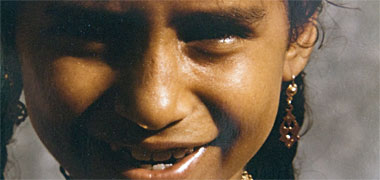
It may be surprising to see, but children and even babies may have their ears pierced and starter jewellery or a piece of thread inserted, the latter presumably prior to jewellery taking its place. My suspicion is that this may be a continuation of traditional habits, but reinforced by the new trends to personal adornment. It is not just a Muslim or Arab habit as, in the West, there are many parents who dress their children in an adult manner, apparently to show them off, though there may be a number of different motives for this practice.
Cosmetic surgery
It may seem a little odd to include this subject, but it is here in relation to the injunction, set out above, against damaging the body. Islamic scholars hold that there may be a case for the body to be operated on when there is a need to correct a feature for medical or, perhaps, psychological reasons, but that for what may be considered vanity it is not permitted. Whatever the reasons for and against the increasing practice in the West of surgery for cosmetic reasons, this is being mirrored in Qatar to the extent that no longer do women have to travel to the West for surgery, but it is now provided for within the country.
Henna and kohl
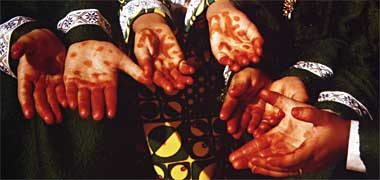
More often, children can be seen with their hands and feet patterned with henna. Here a group of children have had henna applied it to their hands prior to a party. You can see that the work is relatively crude and will have been carried out by themselves, as this may be compared with the more mature work shown in the photographs below. Often children will have the soles of their feet dyed with henna.
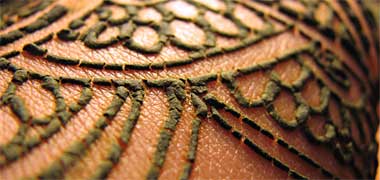
The practice of using henna for personal adornment has always been associated with special events, particularly weddings, but many take pride in using the plant at regular intervals to decorate the skin and nails of their their hands as well as their feet. It is important to be seen looking good at the parties which occur weekly, and it should be borne in mind that henna fades with time. This first photograph illustrates the manner in which henna is applied.
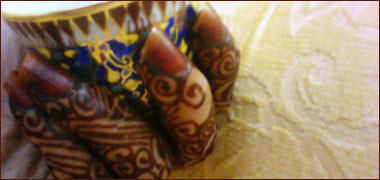

The crushed plant, together with lemon juice or other similar medium, is painted on as a paste with a stick or special pen, the process taking some time to apply depending on the complexity of the design. The wearer then has to wait between four and six hours before the henna is washed off leaving a red stain whose darkness depends on the length of time the henna paste remained on the skin. The next two photographs illustrate henna patterns applied to hands. The first, incidentally, is holding a finjaan, the traditional coffee cup that looks very much like an egg cup to Westerners. As you can see, the patterns in both photographs are curvilinear and do not appear to be particularly Arabic in character. My understanding is that the decoration does not cover the whole of the hand but mainly the palm of the hand and the fingers up to the knuckles. I admit I don’t know what the rules are for coverage but I have also seen decoration of the back of the hand.

This pair of hands decorated with henna is interesting as it represents a different kind of pattern from the traditional Qatari henna patterns. The decoration is similar to the photo above in that it is a cursive design, but it is not an Arabic style owing more, perhaps, to the Indian sub-continent with its free-form design, lack of containing geometry and irregularity. Note, incidentally, the application of henna to the finger tips. With close links for centuries with the Indian sub-continent, it can be anticipated that there are many design features which take hold in the Gulf.

Compare the photograph above with this, of a different pair of hands. That above shows the design completed, as it would be seen day-to-day. But here is another design that has been marked out with henna paste, the wearer having to wait for the staining process to take effect and create the designed pattern. Note that the paste is less red than the finished staining, and that the ends of the fingers have had the henna paste applied as was the case with the hands above.

This photograph may seem out of place here, but is added as it relates to the use of henna. The foot is of a saluqi hunting dog that has been stained with henna. These animals are loved and well-treated by their, predominately, badu owners and, as with shaheen, considerable effort is taken in maintaining them in good health. While the henna might be considered decorative adornment on humans, on salaq the treatment is chiefly as a hardening medium for the animal’s pads as well as giving a degree of protection above the foot from the stones and thorns of the desert. I understand that it is additionally considered to be a medicinal prophylactic application, guarding against problems caused by cuts and abrasions, though can’t confirm this. A little more has been written about salaq on the previous page.
kohl has also been used for centuries, its particular application being as an eye-liner. When properly applied right next to the white of the eyes and at the root of the eye lashes it dramatically accentuates the eyes. It is one of the most common adornments used by women and is also used to darken eyelashes and eyebrows.
However, kohl is a dangerous compound, differing in its constituents from place to place but often incorporating material such as soot, lead and antimony compounds, the latter of which would have entered the blood stream and, of course, are poisonous. Counter-intuitively the metal compounds may have helped in reducing bacterial infection and the soot would have encouraged the eye to make tears, again an aid to clearing possible infections. Nowadays the market provides safer products but there are still a number of products produced within the Middle East – as well as by families from traditional recipes – which may not be entirely risk-free.
Hair
Finally, just as in the West, considerable attention is paid to woman’s hair. Only members of the family and women friends are likely to see a woman’s hair as it is required to be covered in case it inflames men’s senses. Generally, hair is kept long and is often dyed with a black colourant or with henna which is both a colourant as well as a treatment. Whatever the treatment it is usually finished with oils to give it a lustrous shine. This used to be carried out within the home but, increasingly, women will go to a salon to have their hair trimmed, treated and styled.
While the hair is kept covered there have been times when it was exposed, most traditionally to shame their menfolk into going into battle. This can still be seen in some forms of traditional dance when, usually, young girls sweep their hair from side to side as they dance.
However, as mentioned above, women commonly see each other at parties when they will be dressed and groomed to impress. At these times hair is often uncovered but may be decorated with a variety of materials, jewellery and flowers, real or artificial.
Clothes and display
What I have described shows that a significant amount of time and expense is laid out in dressing both for women and men. It’s interesting that the Holy Quran enjoins Muslims to show respect to each other and dress might be seen to be a potential area of difficulty. I have commented elsewhere on this tendency to display at the expense of others in terms of individual houses, but it also applies to dress. Generally it seems to me that this tendency is just about kept in check with clothes, but that the jewellery can be extraordinarily expensive and a potential source of envy. Certainly jewellery is one of the main areas for serious shopping and, just like the rest of their clothes, new acquisitions are a source of pride and display. It is symptomatic of the period that Qatar and other Gulf states are going through that there should be this conflict with Islamic traditions. My concern is for the dichotomy this establishes in the minds of Qataris.
more to be written…
Other artefacts
Before I mention other artefacts I should just make a note on the Qatari love of artefacts generally. If you look at the photographs which Qataris put up on the Internet you will see that a lot of the photos are of very expensive items. This may not be surprising where there is so much disposable income, particularly by the young, but what is noticeable is the apparent love there is purely for the sake of the objects themselves which can be seen in the way in which they are photographed. This is demonstrated with jewellery and similar items for women, and not only watches and cars for men, but hand guns. I should also add that there is a strong theme of romanticism in many of the photographs, but I shall write about that elsewhere.
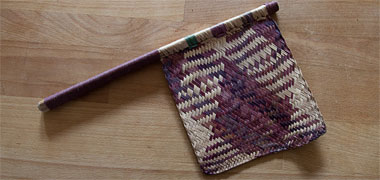
I want to add some of the traditional artefacts that were a part of Qatari life, but it is difficult to include them on this page other than in a rather arbitrary manner. This photo is of a traditional fan. About 350mm long, constructed of a palm stem handle bound and whipped with cord, it has dyed, woven palm leaves, and is a very effective aid to cooling the face and body. Used by men, it seems to have gone out of fashion, though is occasionally spotted being used by the older generations. I have also seen it used to assist a charcoal fire for preparing qahwa.
Crime, vandalism and litter
I have written a little about graffiti and tagging on the approach page but will write more here. What I would like to concentrate on is the aspects of crime, vandalism and litter with regard to society.
It may be thought that the three subjects don’t have much in common but there are significant links in the minds of law enforcement agencies. Obviously there are some crimes that are not linked to vandalism, graffiti and litter but for many, low-grade but still significant crimes, there is a link. Let’s have a look at them in what might be considered the reverse order of importance.
Litter
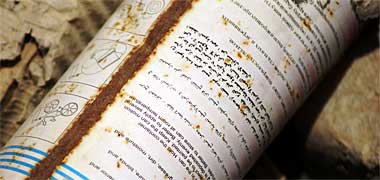
Increasing affluence, less police on the ground, the loosening of family and social structures, the lack of education in citizenship and the sale of more consumer items and their packaging are some of the reasons given for the increase in littering in the West. It is now a well recognised problem – to the extent that some local authorities have established wardens who will issue fines on the spot from people they see littering. Although the policing of littering has not yet come about, the underlying problem is not that different in Qatar. All over the country, both in urban and rural situations, there is litter strewn around. There is, at best, a casual attitude to the disposal of rubbish.

However, it seems that a large part of the litter which is readily seen both in urban areas as well as in the desert is not left by individuals but by larger operations such as the construction industry, the handling of trash, uncovered lorries and the like. With time the control of this type of activity will improve both in terms of the capabilities of the drivers and their loading and protection of materials as well as their collective understanding of the need to move materials safely and to preserve the cleanliness of the environment. But this will also have to be buttressed by laws and systems to control these operations better than the above photograph suggests.

This is an imperative as fly-tipping has been endemic for years. This may not have seemed much of a problem in the past where there was not that much to throw away, and when many waste materials might be reused. But the problem has a far greater visual dimension nowadays and the practice now tends to characterise the outskirts of all urban areas. Mixed with the physical expansion of the urban areas by the construction industry it seems that the litter is continually moving outwards, its fringes undefined, a characteristic which seems to encourage fly-tipping and the like. It also seems to many that the apparent increase goes largely noticed, and unpunished. Here a significant quantity of industrial rubbish has been dumped adjacent to sand dunes. With time it might be thought that the dunes will cover it, but there really is no reason for this thinking to be perpetuated.
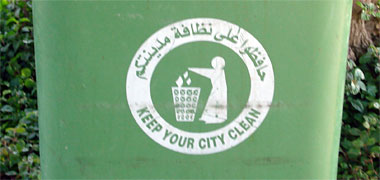
Regrettably, these major sources of littering seem to represent a more widespread problem: people seem increasingly inclined to throw away anything so it is also apparent in urban areas. A major factor in this is the availability of fast food and the changing habits of the national population as well as the larger numbers of expatriates living and working in the country. Litter is something that is readily seen and contributes to our impressions of a place. But it has a more serious side-effect in that it encourages infestation and the diseases associated with it. This is more important in the area of the Corniche where the method of construction has created voids which harbour vermin. The State is attempting to encourage people to dispose of their refuse sensibly by providing bins in public places. The bins are standard green plastic receptacles which promote function over form. But, as obtains all over the world, there are serious cultural difficulties to be overcome before everybody will be induced or impelled to use them. There is also the ambiguity created by the municipalities who employ staff to clear refuse and litter which, in turn, tends to encourage people to litter in the knowledge that others are paid to clear it up.
There is a theory that Arabs have a different attitude to the ownership of space and behaviour in it from that which we have in the West. It is argued that they have little consideration for its being kept in good order, the theory being that they do not own it and therefore see no reason to maintain it. This, of course, is exactly the same reason that is given to explain why people litter in the West. There people argue that it’s somebody else’s problem, everybody else does it, and that somebody else will pick it up.
My experience in Qatar is different from this. In the old areas of the main towns the public areas were spotless. It might be argued that this was because each area was owned by its feriq and that everybody was involved in their collective responsibility. But my memory is that the streets were also clean, these being areas that it might be expected would collect litter. This is certainly in line with basic tenets of Islam, as I have mentioned elsewhere.

I believe that the construction industry has been responsible for damaging and littering all over the state, and that this, together with the advent of fast food outlets and rising consumerism, have combined to create the need for improved municipal cleaning systems. I am not singling out this particular supermarket and fast food outlet, of course, but you can see from the cars and trucks in front of it that it, along with the numerous other outlets are popular places to eat. The good news is that, once in place, they have been relatively efficient due to their being manned by expatriates who have an incentive to remain in the country. But this efficiency does little to stop people littering: in fact it is argued that it encourages it, and it surprising how far afield this litter can be found from its place of purchase.
What is necessary is strict policing and, particularly, an effort to improve the handling of rubbish in the residential areas. Qatar seems to have got the public areas under control but it is worth repeating that this is due in large measure to the municipal systems rather than a change in attitude by the public.
Graffiti

However, this first example has considerable charm to it and although drawn on a wall where it might be thought by Westerners to be a graffito, may have been considered a work of art by the person who put it there as he added his name and date. It reads ‘Drawn by the student Hassan Abdullah’, below which is added ‘Year 1967’. The building in which it sits was probably a schoolroom and the stylised masjid with its burj may have been actively encouraged as a mural decoration. Although at first glance the structure appears to have external influences, the qibla and its finial have specific roots in the peninsula as do the stylised decorations within the central door and the apparent pattern of the Qatari flag on the burj.

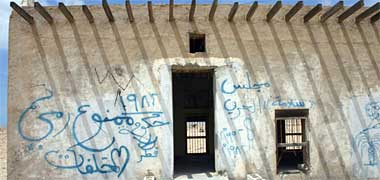
But graffiti has now developed from its informal, mindless or rebellious character and now is both a major art form as well as a cause for concern in many parts of the world. In Qatar there were always small displays to be seen but they tended to be relatively naïve, apparently the work of children, and were to be found mainly in areas that Qataris had left or where there was a mix of nationalities – Qataris and expatriates. These two photographs are typical of the type, both having been produced in the nineteen-seventies. Housing areas in the Gulf, perhaps more so than in the West, generally form a friendly environment because of the character of both the old and new houses and the nature of the Islamic society. There is a wide variety and large extent of plain surfaces – notably walls – together with a ready availability of tools and materials facilitating graffiti, particularly the spray paint can. But it surprises me that the normal controls which Arabs exercise has not stopped this character of graffiti. I can only assume that here it has to do with the lack of direct supervision, these two examples being derelict buildings.

Until recently graffiti did not measure up to some of the artistic standards that have been developed in the West and are usually based on names – often with a fairly skilful use of calligraphy – and simple drawings, usually crude: much, in fact, as there was in the West twenty or so years ago. Here some relatively simple words have been sprayed in Arabic and English.
There is a small amount of political graffiti in Qatar though it doesn’t relate to Qatar but to pan-Arabic issues. As there is a significant police presence in most areas, it’s likely that this has an influence on the amount of graffiti of a political nature and, perhaps, on other works, particularly in any that would take time to execute. There is very little tagging – indicators of territorial ownership. As I mentioned above, there was until recently no artistic graffiti which I think is surprising as Arabic calligraphy is ideally suited to artistic interpretation. But that is no longer the case.

This spray painting can hardly be considered as graffiti but I have included it here as I think it significant. One of the characteristics I have written about elsewhere on this page relating to expatriates living in Qatar is their identification with the country where they work while needing to maintain a place they can call home – in this case, literally. It illustrates a rather touching need to identify their house, and to do so with what is now a readily available tool, the spray can, a significant improvement on the paint can and brush. It is an interesting illustration of the way in which the walls of this old property are seen to be available for signing.

Here, however, is something a little different. On the walls of two different buildings, two different hands have crudely sprayed the word for Satan – shaitaan, the lower graffito having the number ‘420’ added after it which, I’m told, is an insult in Pakistan and Afghanistan. I have no idea why these have been sprayed nor how the number ‘420’ came to be associated with an insult. They are obviously not political but, perhaps, mischievous as they appear to have been written by immature hands, particularly the first, and may well have been produced by expatriates on the evidence of the added ‘420’. I would love to know if there was a specific purpose behind them, or if they are just examples of the mindlessness we are used to in the West. Still, it seems strange to see this word sprayed on walls in an Islamic country where the significance is very different from the way it would be understood in the West.

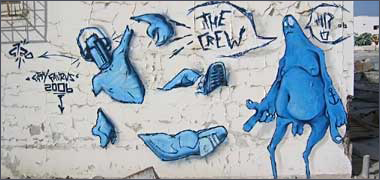
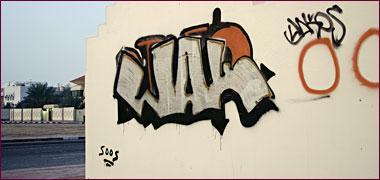
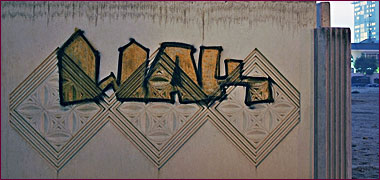
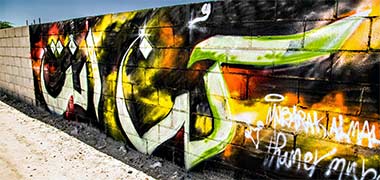

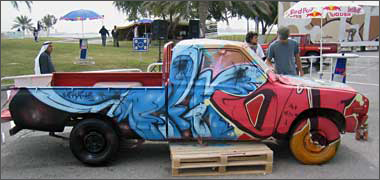

I have termed the above graffiti ‘art’ and realise that many will not see it as that. In order to give a little more context to this I will include here two more photographs of painted cars in Qatar, again an art form that has developed in the West and which can be seen to relate to the graffiti associated with painted walls. I understand that these are the first two examples of their type in Qatar. In the West customised cars are relatively common with considerable funds expended on the art work and specialised paint shops set up for this specific art form. Customising has caught on to the extent that graffiti artists are now sought to make ‘legitimate’ works of art, usually by those who can afford it privately, and the advertising industry – the most famous graffiti artist, perhaps, now being ‘Banksy’

Customising cars is not a new trend but became affordable when cars became more available. The sixties and seventies saw, in the West, considerable interest in painting not just cars but a wide variety of objects. In effect it was an extension of the fashion industry. In Qatar, the country had not yet caught up with this trend at the time, nor has there been a subsequent cross-over from the fashion world apart from examples such as the cars above. There has, however, been a visible trend to show allegiance to both Qatar and to the State. It’s very common to see stickers on cars not only referring to the State but also to the Ruler. This feeling is supported in many areas, noticeably photography where the emphasis is more on the country as an abstract notion rather than on its governance. But, here, the owner of this car has decorated it to show his connection not just to the State – as can be seen by the Qatari flags on the car’s roof, but also other States as can be seen on the stickers on the sides of the car.
Vandalism
A sadder form of vandalism than graffiti is that which damages or destroys and, in this, authorities in Qatar have a similar attitude to those in the West. It is possible to see all over the State the results of deliberate acts of vandalism, often carried out on newly constructed works. A particular disappointment was the deliberate smashing of all the perforated naqsh panels in the Municipality of Doha’s decorative boundary walls located at the junction of the Television Road and ‘A’ Ring Road in the New District of Doha, and adjacent to the State Plaza. It is not known who carried out the destruction but it was thought to be a disgruntled worker rather than a piece of mindless violence as similar acts often happen on works under construction.
One specific facet of vandalism that has been established is the connection between the incidence of vandalism and the attitude of the community to their general safety. It has been demonstrated that vandalism signifies that the area is no longer safe. This is perceived not only by the residents, but also to vandals and criminals. It is for this reason especially that the police wish to stop graffiti as they are aware of the probably consequences with the area being opened up to increasing vandalism and crime.
In traditional Arab societies it is argued elsewhere that the individual takes on a number of responsibilities in the public arena. In ordering his own life in relationship to his family and friends, he assumes the right to help police his neighbourhood in a social sense. Despite the containing of his family’s life behind the wall of the house there is, nevertheless, a keen interest if not a requirement that he help keep order within the wider society, certainly within his feriq. It has been noticeable for some time that Qataris have shown a strong interest in the actions and results of crime, as well as a concern for perceived problems that might affect them personally or collectively within their own neighbourhoods. The increase in graffiti and of vandalism is a cause of concern to many of the residents of Qatar, particularly when it is now seen within newer areas of housing.
This form of vandalism is considered to be similar in essence to that which focuses on elements such as street furniture. Both cars and street furniture mimic to some extent play equipment – both of them responding to our need to learn through play. It is argued that we all have a need to enjoy some form of exhilaration that is satisfied by a variety of forms of vandalism. Vandalism, particularly, has an element of danger in it which is perceived to be fun, exciting and free and, in this, it mimics our enjoyment in many ways. How this is to be dealt with by Qatar society has not been fully defined yet, perhaps because of differing attitudes to its extent and relative importance, and perhaps because it has yet to reach the epidemic proportions of some parts of the West.
Crime
The police in Qatar are effective and maintan a highly visible profile. The individual is generally safer in many respects than he would be in any country in Europe with regard to crimes against the person, theft and burglary. Nevertheless, as stated above, there is a persistent and growing feeling that crime is rising in Qatar and that it is important to make neighbourhoods safe from crime. In conversation with Qataris it is evident that a number of factors come together to create this opinion. It appears to be related to a combination of:
- historical insecurity where towns were subjected to raids from the desert,
- the feeling of being out-numbered by foreigners,
- a need to protect the family from unspecified potential dangers that exist in a mixed society; and, only to a small extent,
- the outcome of a rise in petty theft, in the main, from the houses of expatriates – and by expatriates.
It is interesting to see that housing for both Qataris and expatriates is conceptually designed to be secure even though crime levels are low. In a society where conspicuous consumption is the norm there exists considerable temptation for those wishing to relieve others of their valuables. However, there is constraint in the knowledge that the police and the Islamic judicial system operate swiftly, prison is unpleasant and, above all, expulsion from the country means an end to any earnings.
There are other forms of crime occuring in the Gulf, just as in Europe, but certainly not to the same extent. Drugs, alcohol and prostitution exist, and smuggling has been a characteristic of the Gulf for centuries. But they are kept more or less in check.
One form of crime has often been commented on as significant in the Gulf and that is corruption. But this, again, has much to do with traditional societal moraes. For centuries Islam has spread not by conquering and enforcing change, but by encouraging adoption and adaptation to a central government. Those put into the conquered lands were required to govern equitably and with considerable latitude, as long as the requirements of the central authority were met. Their reward for this was that they were permitted to benefit themselves, provided that it was not carried to extremes, and that the system provided a good advertisement for Islam.
Governors were, in a similar sense to that which I have written about in tribal groupings, the head of operations in which they were trusted and relied upon to make sound decisions. Wealth was necessary for them in order to benefit those requiring assistance, and they would not keep their positions if they were seen to behave against the interests of those reliant upon them. In a development of this system today, Westerners have complained that they have had to involve themselves unwillingly in what they believe to be corruption in order to be considered for the provision of goods and services.
Yet my understanding is that funds and rewards received in this way have been used to give benefit to others just as they always have. It is not perceived as corruption in the Western sense but as an honest and necessary adjunct to benefitting the society at large.
Wealth is not anathema in Islam. On the contrary, it is the means by which the society achieves those standards on which its success lies – including health, happiness, dignity and the controls which guide and strengthen it both individually and as a whole. Provided wealth is obtained legally and then used in the benefit of others, it is welcomed. Conversely, if the obtaining of wealth is an end in itself, then that is wrong, as are luxury, ostentation and profligacy.
It has to be remembered that Gulf society is far more integrated and inter-dependent than the societies of the West, though I have to admit that reliance on State works and operations – education, medical treatment, street cleaning, utility provision and the like – has loosened the traditional system of societal benefits and the personal relationships that are concomitant with a tribal society. Moreover, the search and competitive provision of goods for markets, and the regularising and documenting of processes such as pre-qualifying and bidding have particularly strained this traditional system, creating new difficulties for those at the heads of the families as they attempt to balance the State’s capabilities and requirements with their own needs or desires to retain their positions.
More than this, the introduction of so many expatriates into the country has increased the opportunities for corruption in a constantly developing and fluctuating society. While expatriates may be concerned for the temporary nature of their stay in the country, this is not necessarily reflected in their behaviour. Deliberate and accidental exploitation is common and difficult for the authorities to identify and control. Policing this character of population is very different from that required for a more traditional, tribal society.
Personal space and ownership
The following comments may seem by some to be generalisations, but I don’t think they are. To some extent they have been drawn from this source but they also reflect my own observations and interest over a long period of time. The notes are here because they relate to the way spaces are used and furnished.
In the West we can usually identify a space which surrounds us and over which, in varying degrees, we enjoy psychological ownership. We term this our personal space. What is unconsciously seen to be intrusion into that space causes discomfort and affects inter-personal relationships. Conversely the space can be used positively to affect relationships with others. But, positive or negative, knowledge of the way in which people relate physically is necessary for a proper understanding of spatial relationships of rooms and, particularly, furniture.
There are significant differences in the way in which Arabs and Westerners regard personal space, and this is reflected in the manner in which buildings are used. At its simplest, an Arab does not have a personal space; consequently there can be no intrusion.
This can be seen not only with behaviour within and around buildings but in the way it affects perception on the roads. In the West we tend to defer to bigger, more powerful, faster and heavily laden vehicles. By contrast, Arabs take on rights to space as they move and, only to the extent that they consider safety to be a factor, will drive in a different manner from Westerners. Conversely, in the West we are likely to dispute space taken by other vehicles because we do not believe that others have the same degree of right to space into which we might be intending to move. ‘Road rage’ is a common reference to the irritation felt for this phenomenon. Arabs might also be thought to drive dangerously close as we might see it but, from their point of view, are just enjoying the companionship of the road.
Not only is the space we think we control believed to be ours, but our body and clothing are seen to be essential elements of our perception and are considered inviolate. We don’t enjoy people coming within our comfort zone, and also feel uncomfortable when we are touched or held by people we don’t know well – or even, sometimes, by those we do. In the West, for instance, when people leave the close confines of a lift, the remaining people will spread themselves out to produce the optimal intrusions into their personal spaces. Arabs will generally stay where they are as they don’t feel there might be a problem.
The concept of personal space is also extended to psychological ownership. For instance the office itself is considered to be under our ownership and, generally, we want to be asked to give permission to anybody wanting to enter.
Arabs are still having difficulties with this concept. Generally, nobody wants to ask permission to enter a private office and will just walk in. Ironically, State development in both the private and public sectors, upward mobility and Western education have conspired to produce isolating mechanisms such as secretaries, office managers and the like to give a degree of privacy that is antipathetic to Arab and badu traditions in particular. Generally the gate keepers don’t stand a chance at keeping a Qatari from going to see another Qatari though there is some degree of privacy or security maintained by Ministers and Heads of Departments if only for operational reasons. Having said that the tradition of being available to all has to be carefully balanced between the need to carry out work and the social need to maintain a position in society. It is a dichotomy that I know is still being struggled with. Concepts of the open office with no walls have not been tested, I suspect because of the hierarchical nature of Government staffing structures.
This has seen the organisation of hierarchies of manned spaces which reflect the management structure but also tend to isolate the person at the apex of the pyramid from others below him – both those working for him as well as those wanting access. It is used by many to demonstrate position but, as I said in the preceding paragraph, there is the danger that this will redound against the individual in his society.
The ownership issue also applies to elements of building we see as ours. For instance, if we sit in our office at our desk, we feel we own the desk and the different items we place and use on it. We can be irritated or made uncomfortable by people placing something of theirs on the desk, or leaning on it or, worse, sitting on ‘our’ chair or even moving ‘their’ chair to a different position.
By contrast the Arab sees the body and ego as dissociated. The effect of this is that Westerners can feel very uncomfortable when an Arab stands close. Yet the Arab is, in a sense, paying a compliment to the Westerner by wanting to become involved. Olfactory senses are important to Arabs in the building of personal relationships. Strong eye contact is also a characteristic of conversation, and is not meant to be hostile as it is perceived by Westerners. Arabs look directly, which is read in the West as staring, and they find it offensive to view people peripherally – both the opposite of Western experience.
The Western four to seven foot socio-consultative distance is disliked by Arabs who find it restrictive if not offensive. Typically Arabs would like to stand close, face their interlocutors, eye directly and touch a lot. To this extent Arabs are not as conscious of the setting in which they meet as we might be in the West. It follows from this that it is rude to maintain a large interpersonal space, look out of the corner of your eye, or take too much interest in your host’s possessions, though this is also derived from social tradition. It must also be remembered that Arabs enjoy an extremely strong verbal tradition which makes conversation a more appreciated form of intercourse than in the West. A friend once said to me – with some degree of truth – that Arabic is a language; English a commercial code…
Arabs derive considerable social enjoyment from the company of others and dislike being alone. For this reason they often feel isolated when travelling in the West as they feel both socially and sensorialy deprived. This participation is echoed in the social need to be involved with any event which they attend whether this is formal or informal. Arabs are involved with each other and the oldest is generally deferred to, if not actually responsible, should the occasion warrant it. In fact, to fail to intervene is seen to take sides.
While I have stated that Arabs dislike being alone they have a characteristic which can be unnerving to a Westerner. When they wish to be alone they do so be retiring into themselves – commonly, just sitting and not talking. To some extent this is a compliment to a Westerner. It means that he is comfortable enough with you to treat you as another Arab rather than having to maintain a traditional, hospitable behaviour. Westerners can be discomfitted by this as we tend to dislike long silences and can take these personally.
With regard to larger spaces – those within which they move – Arabs generally dislike to be physically enclosed with, perhaps, those of badu descent more susceptible to the psychological constraints imposed by buildings. For this reason they like to have large three-dimensional volumes within buildings and, preferably, without too much furniture in them. However, for other reasons, their furniture tends to be relatively large which creates problems for movement in and around those spaces, which I will try to deal with elsewhere.

This unobstructed space is, as I mentioned, three-dimensional with low ceilings being particularly disliked. As a general design requirement ceilings should be high and light and out of the line of normal sight. These three Qataris sitting on a sand dune show the model that should be aimed for…
It would seem to follow that, with a requirement for large unobstructed volumes and high ceilings due to psychological factors relating, particularly, to those of badu origins, it might be anticipated that long views would be a similar requirement. I have not found this to be the case though, where long views were provided, they were certainly enjoyed.
Due to the need to keep the sun out of buildings it is common for there to be considerable shading which, together with dirty fly screens, tends to obstruct possible views. In fact many buildings in the Arab world have a totally controlled internal environment with little or no opportunities to see out of them. I don’t know how these have been received but have not noticed any apparent problems with Arabs using them. Qataris I have asked about this seem not to have thought about it. Some have said they prefer to have a view but they also have said that not having one is not a problem.
I have a possible explanation. I have noticed that Qataris have a very well developed sense of place and orientation. I tend to think that they see themselves, when inside a building, within the context of the surrounding outside space. Given a building plan they will immediately turn it to its true orientation without looking up. This talent is likely to be a factor not just of their need to know the direction of Mecca for daily prayer, but also of their origins when orientation and direction finding were an absolute necessity for them. This is likely to be true for both those of badu stock as well as those who found their living at sea, both fishermen and pearlers.

It is a characteristic of both Gulf Arabs and Muslims that there is consideration for others. It is a basic tenet of Islam and is to be found in many traditional areas of life in the Gulf. One such demonstration is in the provision of drinking water fountains for those passing. This example I believe has been placed here by the State, but it is not uncommon for them to be provided by private individuals, usually built into their external walls rather than free-standing as in this example. The point here is that the responsibility is taken to adopt a part of the public or semi-public domain in order to provide a benefit to others. The design is also interesting.
Health and medical

Some of the medical traditions associated with the peninsula will have changed little over centuries. Nor should those traditions be seen to be restricted to the peninsula. They will have been common to a wide area of both the Arabian peninsula and the Persian side of the Gulf, and in some of those aspects there may well be some which are still either being practised or at least considered in certain circumstances. The most obvious areas of change are the formalising of medical facilities and the introduction of governmental systems providing and administering them, together with the availability of modern pharmaceuticals and the professionals who put them to use. But people themselves have changed with education; no longer are traditional practices such as the circumcision illustrated here the norm.
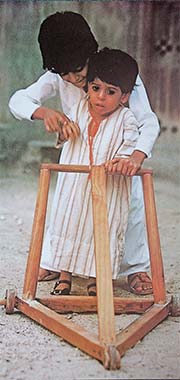
One of the many benefits that wealth has brought to Qatar is the ability to provide a medical system with comprehensive coverage for Qataris and non-Qataris, the former free, the latter subsidised. The first hospital in Qatar was established in 1957 at Rumaillah with two hundred beds. Prior to the nineteen seventies medical facilities were mainly located at Rumaillah, but there were also the Women’s hospital as well as an orthopaedic, long stay facility near the centre of Doha. A number of pharmacies provided patients with the requirements specified by the hospital as well as from private clinics generally associated with the pharmacies.
Generally, there was care provided by those with a concern for the welfare of the sick, distressed and disabled, this being given individually through charitable endowments or initiatives, a characteristic of both Islamic and badu societies.
The 621 bed Hamad Hospital was designed and also constructed at Rumaillah. Opening in 1982, there has been a continuing programme of medical developments associated with it, including the opening of local clinics to serve all areas of the country. Hamad Medical Corporation, established in 1979, manages Hamad Hospital, Rumaillah Hospital and the 334 bed Women’s Hospital as well as these Primary Health Care Centres.
Although the facilities provided in Qatar are excellent, the country still sends patients out of the country for treatment where it is deemed necessary. This process was one that was heavily used in the past and one that operated on the traditional majlis system to obtain private funding, an operation subsumed by the State, taking away much of the importance of the traditional system of obtaining assistance as I’ve written about elsewhere.
The National Health Authority, was established in 2005, and is the organisation overseeing preventative medicine and treatment both in Qatar and abroad as well as nursing education and all private facilities within the country.

Cleaning the teeth and eating are generally carried out with the batula worn. This is effected by moving the batula up slightly with the left hand while using the right to place food or use the miswaak, or toothbrush. Traditionally, the miswaak is a fibrous stick which is obtained from the arak tree, and which has qualities that work to reduce plaque and gum inflammation. It is not uncommon to see men with a miswaak in their mouths, chewing to develop the fibrous ends.
Traditional medicine
Prior to the State providing medical facilities for its nationals and ex-patriates, those who became ill had recourse to one of two systems: private pharmacies and traditional medicine. I doubt if the latter is much pursued nowadays, but it was certainly an established route as late as the nineteen seventies.
It must be remembered that the Muslim world has made considerable contributions to medicine, its work being the focus of the medical world until the fourteenth century and the Renaissance. Men such as Ibn Sinaa, who produced one of the most important medical works written, the fourteen volume al qanuwn fi’l tibb, did much to conceptualise the systems we are familiar with today. During this period significant advances were made in understanding how the body works, the classification of diseases, surgery and treatment. While this work became the basis of Western Medicine, the basic knowledge filtered into, and reamined within, the different parts of the Muslim world at different levels of sophistication.
At its simplest the treatments in traditional medicine in the Gulf were based on three systems:
- bleeding,
- cauterising, and
- herbs.
All three of these methods have also been practised in the West as well as in the Far East. Herbs are still used extensively and form an important part of alternative Medicine though cauterising and bleeding, particularly the latter, have all but disappeared.
Herbs are still used in the Gulf, as they are in the West, to treat a variety of ailments. Some of this is self-administered and is the result of traditions within families or advertising. But cauterising has only recently disappeared. I can recall seeing the marks caused by the practice and was told that it was an effective method. In essence it was similar to the Chinese practice of moxabustion, a procedure which involves the burning of herbs on or above the body to treat a wide variety of ailments. Dr H. A. hajjar Albinali writes that he witnessed both cautery and blood-letting when he was young, noting that it was mainly practised by laymen and badu.
Superstition
As there are in most parts of the world, there are superstitions in the Gulf and Arab world, some of them not understood in the West. Many of them relate to pre-Islamic beliefs and traditional practices, particularly with regard to medicine, the latter having its roots witnessed in a combination of the use of natural plants and burning the skin in specific places as I have mentioned above. However, Islam abhors superstition and magic believing them at best, irrational and, at worst, heresy and prohibited.
Many of these superstitions originated in pre-Islamic times and included holding the month of Safar, up to its thirteenth day, unlucky. This, like other superstitions are now frowned on and have been since the time of the Prophet.
![An owl, with the permission of ~mubarak~[(QTR)] – Flickr An owl](./islamimages/owl.jpg)
But folk superstitions continue in the Arab world as they do in the West. One particular superstition which seems not to be known in the West is that relating to the owl which is regarded as unlucky – a very different position from the West where, generally, the bird is known for its wisdom. The Greeks believed the owl sacred to Athena and thought them wise and kind whereas it was the Romans held the owl to be unlucky. Whether the Roman belief came from the Arab world or vice-versa, I don’t know. In the Gulf, to see an owl is considered unlucky particularly by day; to hear one is worse.
The desert owl is a relatively small bird with beautiful pale markings suited to its natural environment. I was once looking round a building and, sitting down on a sofa was startled by what I had thought to be a small cushion taking off and disappearing somewhere within the building. When I mentioned this to an Qatari friend he immediatlely said I should tell nobody as it would upset anybody who learned about it.
But there is also a widely-held belief in the evil eye, particularly in the older generations. For instance, it was not uncommon for water, over which the Quran had been read, to be sprinkled on children prior to their leaving the house for school.
Black magic
Generally considered to be the opposite of white magic, which is benevolent, black magic has harmful connotations in that it is intended to create difficulties for those against whom it is practised. It is mentioned here in that it seems to be commonly accepted as being practised, or experienced, in Qatar as well as in the Arabian peninsula generally, perhaps because those in the Gulf are perceived to be particularly prone to superstitious beliefs, particularly with belief in the evil eye, mentioned above.
In a sense black and white magic have the same root, it is only their ends which differ with black magic being thought to be responsible for a number of personal difficulties faced by those who believe in it, and encompassing a wide range of perceived problems relating to health, sporting and scholastic activities, love, marital, farming and business problems and many other issues. It might be considered similar to superstition and fortune-telling in that it has to be believed in to be effective.
There is disagreement as to the extent of the relationship of black magic with religion. There are those who associate black magic with satanism so, in order to avoid a certain conflict with Islam, black magic is suggested as being only a mild way of causing harm or difficulty in others. But the very fact that there is harm means that executing it is clearly un-Islamic. It would be seen to be unlawful to practise black magic in order to harm others.
Yet many people do believe in it. In this it might be thought there is an element of naïvety, but black magic is not confined to the Gulf, it is a world-wide phenomenon, albeit it in different forms and with different perceived character and effects.
In Qatar, there are individuals who claim they can counter the effects of black magic and it is in this area that black magic is perceived to be practised – in thwarting or countering it, as opposed to practising it. Where these are not overtly commercial enterprises, it is common to benefit the practitioner for their efforts with a gift. It may appear that those who advertise their activities are expatriates, apparently from the Indian sub-continent, but a number of Qataris, particularly women, are also involved in it.
But countering it commercially may be unnecessary. Recitations of verses from the Quran are considered to be capable of countering the effects of black magic, particularly with the recitation of verse 255 from the Surat al-Baqarah before sleep to protect an individual through the night.
It should also be noted that fortune-telling is contrary to Islam.
Death
Finally, a very brief note on death as there is considerable focus on this and the afterlife in Islam. Death is Divinely ordained and is to be embraced as it is inevitable. It must not be wished for, it may come at any time and every Muslim should be prepared for that event. In Islam death marks the end of the brief life on earth, a temporary separation from loved ones who will, it is anticipated, meet again in an everlasting life following the Day of Judgement.
The loss to death has an effect on those left behind, but their grief is assuaged to some extent in their knowledge that the departed has gone to Paradise to enjoy the life there. Although the loss of babies and the very young can also be an emotionally draining event, again there is a balancing emotion that, as they are young enough not to have committed sins, they will go straight to Paradise.
A significant difference between Islam and Christianity as practised in the West is the manner in which the Muslim community are involved with the death of those in their midst. Death in Islam is much more of a communal event than is now generally practised in the West, and the community take it upon themselves to assist the living and dead through this transitional period.
For those interested to learn more there are better sources to study than this note. It is useful to gain a good understanding of the central precept that life is a period where the Muslim prepares for the afterlife in the knowledge that they will be judged on their deeds at the Day of Judgement. This has much to do with the way in which Muslims behave, or should behave and should be borne in mind in the notes on pressures for change which precedes this page.
Muslims are buried, the burial taking place within twenty-four hours of death. This is not a requirement but has become recognised practice. Generally cremation is not an option and there appear to be three possible reasons for this. Firstly, some authorities hold cremation to be forbidden though I have been unable to find authoritative confirmation of this. Where a person has died by fire then that person is considered to have died as if a martyr and the corpse will be buried with no further desecration to it.
But Muslims believe that there is a Day of Judgement when they will be physically resurrected and, when their bones can be reassembled – sura75:3-4 –
Does man think that We cannot assemble his bones? Nay, We are able to put together in perfect order the very tips of his fingers.
which suggests that Divine intent might readily overcome this.
There is another argument. I have mentioned below of the respect there is for the physical remains of the person and the careful treatment this requires. It might be considered that only in exceptional circumstances should the remains be subjected to a process which is so strongly associated with hellfire.
Hence space must be found for graveyards – maqbarat, preferably within the neighbourhood in which the dead lived.

One of the features of urban Qatar are the maqbarat which are usually associated with the different furuwq in which they are located. They are usually surrounded by a stone wall and are an integrated element of the urban scene, albeit that they are large and usually amorphous. The natural ground of Qatar is rocky limestone, hard to dig into. This photograph illustrates well the character of maqbarat.
You can see from the photograph that maqbarat are austere. There are parts of the Muslim world where graves are marked and decorated but, in strict adherance to Islam, there should be no decoration and the graves should be unmarked. Bodies are buried with their heads towards Mecca.
When a person dies, burial is carried out as quickly as possible, preferably within twenty-four hours as mentioned earlier. The body is treated respectfully and usually washed by the immediate family, women by women, men by men or either by their spouses. This can be carried out at home or in a special place set aside associated with a mosque. It is then wrapped in a white cloth and carried to the maqbara and interred in a hole that is comfortably a little larger than the corpse, while those attending the funeral recite the first verse of the quran and, on completion of the burial, sura20:55 –
From the (earth) did We create you, and into it shall We return you, and from it shall We bring you out once again.
As you will see from the photograph above, the dafnah is piled to form a raised mound in order to discourage sitting or walking on the grave as this is forbidden. I should also have mentioned that the dafnah is carefully placed back into the grave by close relatives using either their hands or shovels and not, as in the West, by grave-diggers. This is another demonstration of the more communal and personal aspect of burial compared with practice in the West.
The funeral ceremony is not carried out in the masjid, but in the open, usually in the maqbara. It is a sombre and quiet event as demonstrations of grief, other than tears, are discouraged in Islam.
I believe that women do not enter the maqbara for the interment but, after the men leave, they enter and recite a prayer over the grave.
Following the funeral the men and women of the family receive friends at their majaalis when the visitors will sit with the head of the family, make formal condolences and take tea and coffee, making way as necessary for new visitors to take their turn in the majlis. On the face of it, it is very much like a normal majlis, though combining formality and informality in a more solemn manner. The majlis is a mechanism of formal recognition by society of the loss to the family, as well as to the society at large, marking the importance to the society of the individual as well as recognising hierarchical continuation.
For the family there is customarily a three day period of mourning following the funeral, marked by increased devotion and prayers together with continuing condolences made by all who knew the deceased. It can be a little surprising to a Westerner to see the numbers of people who come to make their condolences. wahhabi tradition forgoes this three day mourning period.
During this period no jewellery or decorated dress is worn by the mourners. This extends to a widow who has a period of mourning of four months and ten days during which she, additionally, must neither move from her home nor remarry.
When a Muslim dies he or she has no more opportunities to perform acts of righteousness and faith. Interestingly, a hadith holds that there are three benefits still to be enjoyed after death:
- charitable acts made during life which continue to help others,
- knowledge from which people continue to benefit, and
- the prayers of children made for him or her.
The first two of these in particular are responsible for the charitable traditions in Islam, and are symptomatic of the way in which Muslims seek to organise their lives. Muslims believe that death takes people out of this world to an eternal life where their existence continues until the Day of Judgement when they will be resurrected. This sense of a continuum, allied to the implicit belief in the quran, is thought to have a palliative effect on death and moderates grief. It is also responsible for an inherent spiritual and social stability, but a stability threatened by the influences of the West, as I have noted earlier.
Other religions
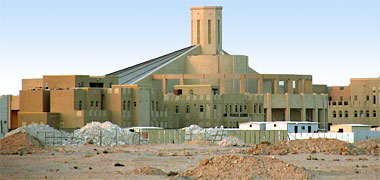
On the 15th March 2008 the first Christian church was consecrated in Qatar. The church of Our Lady of the Rosary has been constructed for the Catholic community in Qatar, a community which has grown steadily with the increase of the expatriate workforce, particularly from the Philippines. Not only is there now a Catholic church in existence, but there are plans to cater for other Christian congregations – Anglican, Coptic and Greek Orthodox, as well as for the construction of an inter-denominational centre for eleven Indian churches.
In the West there are buildings for most religions needing a place for congregational worship and, within certain parameters – mostly planning constraints – this is unremarkable. However, in the centre of the Muslim world, this is certainly an important step and it is interesting to speculate how this more open development will be viewed by Qatari nationals as well as by the states of the Gulf, including Saudi Arabia.
For many years there have been religious meetings catering for expatriates in Qatar. These have been held in a number of different locations with visiting clerics moving around the Gulf to serve the needs of their congregations. The manner in which these operated was relatively informal. They were more or less invisible to the national population, though Qataris employing Christians would most probably be aware of their going to services where there is not just spiritual comfort to be gained but also the meeting of friends and nationals from the many countries which provide personnel to Qatar. These services were held with the tacit but unofficial support of the government. The rationale for this has always been difficult to explain, but appears to consist of a number of arguments whose weight differs from State to State within the Gulf.
There are four issues which need to be understood. At their simplest they are that:
- Islam is centred upon the two most holy cities of Mecca and Mdina in Saudi Arabia – the third being al Quds, Jerusalem,
- while Christianity and Judaism are recognised by Islam, Islam is considered to be the one true religion,
- there is no proselytsing countenanced in the Muslim world, and
- Muslims may not convert to another religion.
While I have stated these as absolute facts, there is some latitude in certain parts of the Muslim world, this being dependent upon both the socio-cultural traditions of the area in which these are considered, and their interpretation in accordance with the Holy Quran and ahaadith. Christian worship is permitted in most of the Gulf, with the exception of Saudi Arabia. Most probably this is because Saudi regards itself as the guardian of the most holy places in Islam. But there is also a hadith which suggests that Islam can not coexist with other religions, though this is open to interpretation.
Qatar has always taken a cautious but tolerant attitude to other religions but, bearing in mind the fact that it derives its character of Islam from wahhabi tradition, the need for caution is evident. Here there is a challenge: on the one hand the need to preserve and protect the status of Islam and, on the other to be generous and tolerant to others – a very Arabic characteristic of hospitality. There is, of course, another more political aspect to this, and that is the need to encourage foreigners to come to the country, bringing their skills and energies to the development of the State. Nevertheless, change brings tensions and the notes on this page relate to the strains that change can bring. Naturally there are those who believe it wrong that Christianity can flourish more openly in an Islamic state. To counter this, the new churches will have to maintain a low profile literally as well a figuratively. But there are also others who, although perhaps not welcoming the development, understand the need and support the initiative to provide spiritual support to foreigners in much the same way as they may enjoy it abroad. It is not an easy process to manage, nor balance to maintain. It will be interesting to see how the Christian authorities control it.
The media
It was my intention to make notes here about the different forms of media available to those living in Qatar, and to comment on where, and the manner in which they are produced, directed and consumed. However, it seems more important to begin with the position of the media in Qatar, and the problems and opportunities they pose and present.
As is the case in the West, there is considerable diversity of opinion voiced by the media of the Arab world. This world consists of disparate States in a variety of stages of evolution and, reflecting this, the media are also developing and diversifying their approach and broadcasts. While we may tend to see the media only in terms of their publications, Arab critics remind us that the media often work to advance the agenda of government at the expense of the public. One of the reasons for this is that the media generally operate in a quasi-governmental manner, sometimes only with its formal or tacit approval. There are exceptions. Qatar, for instance, has introduced Al Jazeera into the country, allowing it to establish and develop into an internationally important voice, one that irritates a number of other States both Arab and Western.
The arguments relating to the operation of the media in many Arab States revolve around political and civil liberties with critics holding that governments support the more cosmetic uses of media while ignoring real policy development. It is held that the lack of development in these areas is increasing the gap between Arabs and their governments. It has to be admitted that this criticism seems to be made of northern Arab States and not necessarily the Gulf, but it is interesting to speculate on the extent to which it might be true in a society that is based on tribal cultures, though is developing in what many see as a Western manner.
One of the areas considered to be significant as representative of change is civil society, those elements of a society that are neither governmental nor market oriented. In general these would be non-governmental non-profit making organisations associated with welfare, charity, development and environment. Bearing in mind the charitable nature of Islam, an important balancing consideration has to be the family together with religious and cultural or tribal societies as these are not classified as civil societies.
The Gulf States are moving through an interesting period. Societal relations – which have been governed by religious and, particularly, family and tribal ties – have developed or are developing into strong citizen-State relationships. The process is held to reflect the general level of security provided by government, instability and insecurity being functions which tend to reinforce the individual’s relationship with family, tribe and religion, as opposed to the State. The media play a strong part in establishing a feeling of security and, as mentioned above, the State has much to do with the manner in which the media operate, as well as their outputs.
This process of change is one that has the potential for societal ambiguity, where the traditional systems of society, particularly the majlis, begin to lose their authority and operation to governmental organisations. Under these conditions individuals experience difficulties in the lack of clarity there is in the processes with which they were once familiar. More than this, some are able to use the process to obfuscate, a procedure inimical to the establishment of clear social systems. An example of this problem is that some claim, for instance, their uncles will no longer help them, but pass them on to unhelpful government agencies.
Generally, in these notes, I have described the majlis system both in its formal sense as well as the main method by which news is passed on, decisions made.
Society 02 | top | Society 04
Search the Islamic design study pages
- Introduction
- Arabic / Islamic design
- Arabic / Islamic geometry 01
- Arabic / Islamic geometry 02
- Arabic / Islamic geometry 03
- Arabic / Islamic geometry 04
- Islamic architecture
- Islamic urban design 01
- Islamic urban design 02
- Islamic urban design 03
- Islamic urban design 04
- Islamic urban design 05
- Arabic / Islamic gardens
- Gulf architecture 01
- Gulf architecture 02
- Gulf architecture 03
- Gulf architecture 04
- Gulf architecture 05
- Gulf architecture 06
- Gulf architecture 07
- Gulf architecture 08
- Infrastructure development
- The building industry
- Environmental control
- Perception
- The household on its lot
- A new approach – conceptual
- A new approach – principles
- A new approach – details
- Al Salata al jadida
- Public housing
- Expatriate housing study
- Apartment housing
- Pressures for change
- The State’s administration
- Society 01
- Society 02
- Society 03
- Society 04
- Society 05
- Society 06
- History of the peninsula
- Geography
- Planning 01
- Planning 02
- Population
- Traditional boats
- Boat types
- Old Qatar 01
- Old Qatar 02
- Security
- Protection
- Design brief
- Design elements
- Building regulations
- Glossary
- Glossary addendum
- References
- References addendum
- Links to other sites